Weaving goddesses of Japan and elsewhere in the world
Japan has several famous weaving myths: the more significant and well known ones are the Amaterasu sun and weaving goddess, and the Tanabata Star Festival folktale of Orihime, the weaving princess and the cowherder prince Hikoboshi, or alternatively, Orihime and Kengyuu (Nojiri, 1973), thought to have been imported from China during the Heian Era (794-1185),based on the Chinese tale, “Tale: The Cowherd and the Weaving Maid/The Parted Lovers” Excerpted below is the version documented by Renshaw and Ihara’s “Orihime, Kengyuu, and Tanabata: Adapting Chinese Lore to Native Beliefs and Purposes“.
In Japan, the star Vega is often called Orihime Boshi (Weaving Princess Star), and Altair is often called Kengyuu Boshi or Hiko Boshi (Puller of Cows Star). … Members of royalty were, of course, associated with the heavens; Tentei (the emperor) being centered at the North Pole. One day, the emperor’s daughter, Orihime, was sitting beside the river of heaven (Milky Way). She had been weaving because her father, the emperor loved the beautiful clothes that she made. On this particular day, she was very sad because she realized that she had been so busy that she didn’t have time to fall in love. Her father, Tentei, the ruler of the heavens, felt sorry for her and arranged a marriage with Kengyuu (who lived across the river, the Milky Way). Their marriage was one of sweetness and happiness from the start; and everyday thereafter they grew happier and happier. But Tentei became very angry, because in spending so much time in her happy marriage, Orihime was neglecting her weaving. Tentei decided to separate the couple, so he placed them back in their original places, separated by the Milky Way. On only one night of the year would he allow them to meet, the 7th day of the 7th month. Every year on that day, from the mouth of the river (the Milky Way), the boatman (of the moon) comes to ferry Orihime over to her beloved Kengyuu. But if Orihime has not done her weaving to the best of her skills and ability, Tentei may make it rain. When it rains, the boatman will not come (because the river is flooded). However, in such a case, Kasasagi (a group of magpies) may still fly to the Milky Way to make a bridge for Orihime to cross.
Tanabata may be translated as “weaving with the loom (bata) placed on the shelf (tana)”, and the festival celebrates improvement of technical skill and ability. As in China, ancient Japanese added specific values to their wishes that Orihime hone her skills and work hard so that she could meet Kengyuu. In modern celebrations of Tanabata, people throughout Japan write wishes (generally for themselves or relatives) to the kami (deity) Orihime on colorful strips of paper. On the evening of Tanabata, they tie these paper wishes to freshly cut bamboo.
Depending on regions, the Tanabata Star Festivals celebrated on July 7 or August 7 (which is around the seventh day of the seventh month in the lunar calendar) in Japan.
Qixi Festival (Chinese: 七夕節), also known as the Qiqiao Festival (Chinese: 乞巧節), is a Chinese festival that celebrates the annual meeting of the cowherd and weaver girl in Chinese mythology.[1] It falls on the seventh day of the 7th lunar month.[2][3] It is sometimes called the Double Seventh Festival,[4] the Chinese Valentine's Day,[5] or the Magpie Festival. This is an important festival, especially for young girls.[2]
The festival originated from the romantic legend of two lovers, Zhinü and Niulang,[1][6] who were the weaver maid and the cowherd. The tale of The Weaver Girl and the Cowherd has been celebrated in the Qixi Festival since the Han Dynasty.[7] The earliest-known reference to this famous myth dates back to over 2600 years ago, which was told in a poem from the Classic of Poetry.[8] The festival inspired Tanabata in Japan and Chilseok in Korea.
Mythology
The general tale is about a love story between Zhinu (the weaver girl,
symbolizing Vega)
and Niulang (the cowherd, symbolizing
Altair).[1]
Their love was not allowed, thus they were banished to opposite sides of the
Silver River (symbolizing
A young cowherd, hence Niulang (Chinese:
牛郎; literally "cowherd"),
came across a beautiful girl--Zhinü (Chinese:
织女; literally "weavergirl"),
the seventh daughter of the Goddess, who just had escaped from boring heaven
to look for fun. Zhinü soon fell in love with Niulang, and they got married
without the knowledge of the Goddess. Zhinü proved to be a wonderful wife,
and Niulang to be a good husband. They lived happily and had two children.
But the
Goddess of Heaven (or in some versions, Zhinü's mother) found out that
Zhinü, a fairy girl, had married a mere mortal. The Goddess was furious and
ordered Zhinü to return to heaven. (
Traditions
Young girls partake in worshiping the celestials (拜仙) during rituals.[2] They go to the local temple to pray to Zhinü for wisdom.[3] Paper items are usually burned as offerings.[10] Girls may also recite traditional prayers for dexterity in needlework,[3][11] which symbolize the traditional talents of a good spouse.[3] Divination could take place to determine possible dexterity in needlework.[10] They make wishes for marrying someone who would be a good and loving husband.[1] During the festival, girls make a display of their domestic skills.[1] Traditionally, there would be contests amongst young girls who attempted to be the best in treading needles under low-light conditions like the glow of ember or a half moon.[10] Today, girls sometimes gather toiletries in honor of the seven maidens.[10]
The festival also held an importance for newly-wed couples.[2] Traditionally, they would worship the celestial couple for the last time and bid farewell to them (辭仙).[2] The celebration stood symbol for a happy marriage and showed that the married woman was treasured by her new family.[2]
During this festival, a festoon is placed in the yard. Single and newly-wed women make offerings to Niulang and Zhinü, which may include fruit, flowers, tea, and face powder. After finishing the offerings, half of the face powder is thrown on the roof and the other half divided among the young women. It is believed that by doing this, the women are bound in beauty with Zhinü. Tales say that it will rain on this fateful day if there's crying in heaven. Other tales say that you can hear the lovers talking if you stand under grapevines on this night.
On this day, the Chinese gaze to the sky to look for Vega and Altair shining in the Milky Way, while a third star forms a symbolic bridge between the two stars.[7] It was said that if it rains on this day that it was caused by a river sweeping away the magpie bridge, or that the rain is the tears of the separated couple.[12] Based on the legend of a flock of magpies forming a bridge to reunite the couple, a pair of magpies came to symbolize conjugal happiness and faithfulness.[13]
In popular culture
- Barry Hughart's fantasy novel, Bridge of Birds, is loosely based upon this story, though the two figures are switched. The girl is forced to remain on earth, while her male paramour is in the heavens. She is a peasant girl, and he shepherds the stars.
- In the 2010 remake of The Karate Kid, the protagonist attends this festival with his female companion and sees the story reenacted in a shadow play.
- American post-hardcore band La Dispute's song "Four" is written about an alternative version of this story, with a Great King taking the role of separating the lovers, due to her neglecting her duties at the loom. In this version the lovers are a princess and a shepherd, and it replaces all the mythology in the original story. La Dispute's first LP has a recurring theme of this story, including the album title: Somewhere At the Bottom of the River Between Vega and Altair.
- In Kamen Rider Den-O, the series' second rider, Kamen Rider Zeronos, was based heavily on this legend. His Altair form had the motif of a bull (linking to Altair's occupation as a cowherd), his Vega form uses a spool of thread for the visor (linking to Vega's occupation as a weaver). The sole link between the forms is an imagin called Deneb, linking to the bridge that can reunite the lovers.
See also
OTHER ANTONIO VEGA DREAMS BY DEE FINNEY
-
GLOBAL CHANGE LIFE EXTENSION
Apr 18, 2008 – ... hell to pay if they changed it. Other Antonio Vega dreams: ... to the Star Vega ... This is the position that Antonio Vega, his companion and I ..
-
THE RETURN OF THE FEMININE
3-14-05 - DREAM - I was in high school with Antonio Vega (from One Life to Live TV show and his ... This is the position that Antonio Vega, his companion and I -
THE ARCHONS - Dreams of the Great Earth Changes
Jul 3, 2005 – Antonio Vega started talking and we could hear his words but we weren't paying particular attention to him, but then someone said that he ...
-
GIANTS IN WISCONSIN - Dreams of the Great Earth Changes
because that was what Antonio Vega was. When we got to the corner, Antonio Vega and Aiden came out (Aiden is a Detective) Antonio Vega said, "Why don't ... -
DEE - Dreams of the Great Earth Changes
I met the supervisor of maintenance Antonio Vega from One Life to Live TV show and complained about it. I told him that if he didn't have the job done right, ...
-
WORM HOLES, STARGATES, AND TIME TRAVEL
Apr 15, 2000 – I didn't show Antonio Vega the creatures wired together inside the receiver, but I told him how pretty they were as each creature was a different ...
-
DEES DREAMS AND VISIONS - Dreams of the Great Earth Changes
May 2, 2005 – Other Antonio Vega dreams: THE RETURN ... Antonio Vega from One Life to Live TV show came and lay on the floor with the ... Antonio Vega ...
-
DEES DREAMS AND VISIONS august 2012
Aug 1, 2012 – The first man I met was Antonio Vega. I've dreamed of him many times before so I know him very well. There was an instant attraction between ... -
Dee Finney's blog October 17, 2012 page 342 NEW MOON - CROP ...
Oct 17, 2012 – 3-14-05 - DREAM - I was in highschool with Antonio Vega (from One Life to Live ... This is the position that Antonio Vega, his companion and I -
DEE - Dreams of the Great Earth Changes
Apr 1, 2009 – ... the elevator, and said that a young man I had seen with David earlier (he looked like Antonio Vega) was in the elevator stabbed in the chest.
Dee Finney's blog - December 9, 2011 - page 79 - BOOK OF RULES
Dec 9, 2011 – Antonio VEGA showed me a book he had which had a story in it about a place ... the lawyer from One Life to Live TV show and was all about ... -

The Milky Way is the galaxy that contains our Solar System.[12][13][14][nb 1] This name derives from its appearance as a dim "milky" glowing band arching across the night sky, in which the naked eye cannot distinguish individual stars. The term "Milky Way" is a translation of the Classical Latin via lactea, from the Greek γαλαξίας κύκλος (pr. galaxías kýklos, "milky circle").[15][16][17] The Milky Way appears like a band because it is a disk-shaped structure being viewed from inside. The fact that this faint band of light is made up of stars was proven in 1610 when Galileo Galilei used his telescope to resolve it into individual stars. In the 1920s, observations by astronomer Edwin Hubble showed that the Milky Way is just one of many galaxies.
The Milky Way is a
barred spiral galaxy 100,000–120,000
light-years in diameter containing 100–400 billion
stars. It may contain at least as many
planets.[18][19]
The
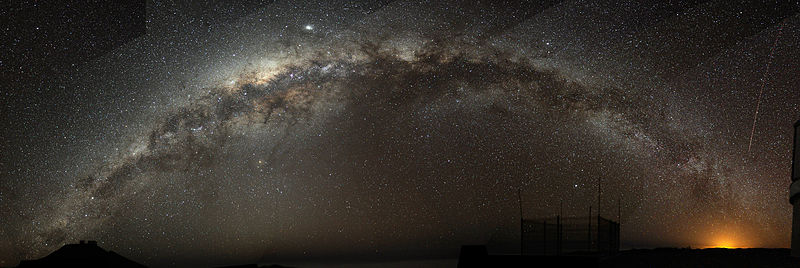
When observing the night sky, the term "Milky Way" is limited to the hazy
band of white light some 30 degrees wide arcing across the sky[21]
(although all of the
stars that can be seen with the
naked eye
are part of the Milky Way Galaxy[citation
needed]). The light in this band
The Milky Way has a relatively low surface brightness. Its visibility can be greatly reduced by background light such as light pollution or stray light from the moon. It is readily visible when the limiting magnitude is +5.1 or better, while showing a great deal of detail at +6.1.[22] This makes the Milky Way difficult to see from any brightly lit urban or suburban location but very prominent when viewed from a rural area when the moon is below the horizon.[nb 2]
The Milky Way passes through parts of roughly 30 constellations. The center of the Galaxy lies in the direction of the constellation Sagittarius; it is here that the Milky Way is brightest. From Sagittarius, the hazy band of white light appears to pass westward to the Galactic anticenter in Auriga. The band then continues westward the rest of the way around the sky back to Sagittarius. The fact that the band divides the night sky into two roughly equal hemispheres indicates that the Solar System lies close to the Galactic plane.[citation needed]
The Galactic plane is inclined by about 60 degrees to the ecliptic (the plane of the Earth's orbit). Relative to the celestial equator, it passes as far north as the constellation of Cassiopeia and as far south as the constellation of Crux, indicating the high inclination of Earth's equatorial plane and the plane of the ecliptic relative to the Galactic plane. The north Galactic pole is situated at right ascension 12h 49m, declination +27.4° (B1950) near beta Comae Berenices, and the south Galactic pole is near alpha Sculptoris. Because of this high inclination, depending on the time of night and the year, the arc of Milky Way can appear relatively low or relatively high in the sky. For observers from about 65 degrees north to 65 degrees south on the Earth's surface the Milky Way passes directly overhead twice a day.
Size and composition
The stellar disk of the Milky Way Galaxy is approximately 100,000 ly (30 kpc) in diameter, and is, on average, about 1,000 ly (0.3 kpc) thick.[2][3] As a guide to the relative physical scale of the Milky Way, if it were reduced to 100 m (110 yd) in diameter, the Solar System, including the hypothesized Oort cloud, would be no more than 1 mm (0.04 in) in width, about the size of a grain of sand. The nearest star, Proxima Centauri, would be 4.2 mm (0.2 in) distant.[nb 3] Alternatively visualized, if the Solar System out to Pluto were the size of a US quarter (25 mm or 1.0 in in diameter), the Milky Way would have a diameter of 2,000 kilometers, an area approximately one-third the size of the United States.[23]
The Milky Way contains at least 100 billion stars[24] and may have up to 400 billion stars.[25][26] The exact figure depends on the number of very low-mass, or dwarf stars, which are hard to detect, especially at distances of more than 300 ly (90 pc) from the Sun. As a comparison, the neighboring Andromeda Galaxy contains an estimated one trillion (1012) stars.[27] Filling the space between the stars is a disk of gas and dust called the interstellar medium. This disk has at least a comparable extent in radius to the stars,[28] while the thickness of the gas layer ranges from hundreds of light years for the colder gas to thousands of light years for warmer gas.[29][30] Both gravitational microlensing and planetary transit observations indicate that there may be at least as many planets bound to stars as there are stars in the Milky Way,[18][31] while microlensing measurements indicate that there are more rogue planets not bound to host stars than there are stars.[32][33] The Milky Way Galaxy contains at least one planet per star, resulting in 100–400 billion planets, according to a January 2013 study of the five-planet star system Kepler-32 with the Kepler space observatory.[19] A different January 2013 analysis of Kepler data estimated that at least 17 billion Earth-sized exoplanets reside in the Milky Way Galaxy.[34] Such Earth-sized planets may be more numerous than gas giants.[18] Besides exoplanets, "exocomets", comets beyond the Solar System, have also been detected and may be common in the Milky Way Galaxy.[34]
The disk of stars in the Milky Way does not have a sharp edge beyond which there are no stars. Rather, the concentration of stars drops smoothly with distance from the center of the Galaxy. Beyond a radius of roughly 40,000 ly (12 kpc), the number of stars per cubic parsec drops much faster with radius,[35] for reasons that are not understood. Surrounding the Galactic disk is a spherical Galactic Halo of stars and globular clusters that extends further outward, but is limited in size by the orbits of two Milky Way satellites, the Large and the Small Magellanic Clouds, whose closest approach to the Galactic center is about 180,000 ly (55 kpc).[36] At this distance or beyond, the orbits of most halo objects would be disrupted by the Magellanic Clouds. Hence, such objects would probably be ejected from the vicinity of the Milky Way. The integrated absolute visual magnitude of the Milky Way is estimated to be −20.9.[37]
Estimates for the mass of the Milky Way vary, depending upon the method and data used. At the low end of the estimate range, the mass of the Milky Way is 5.8×1011 solar masses (M☉), somewhat smaller than the Andromeda Galaxy.[38][39][40] Measurements using the Very Long Baseline Array in 2009 found velocities as large as 254 km/s for stars at the outer edge of the Milky Way.[41] As the orbital velocity depends on the total mass inside the orbital radius, this suggests that the Milky Way is more massive, roughly equaling the mass of Andromeda Galaxy at 7×1011 M☉ within 160,000 ly (49 kpc) of its center.[42] A 2010 measurement of the radial velocity of halo stars finds the mass enclosed within 80 kiloparsecs is 7×1011 M☉.[43] Most of the mass of the Galaxy appears to be matter of unknown form which interacts with other matter through gravitational but not electromagnetic forces; this is dubbed dark matter. A dark matter halo is spread out relatively uniformly to a distance beyond one hundred kiloparsecs from the Galactic Center. Mathematical models of the Milky Way suggest that the total mass of the entire Galaxy lies in the range 1–1.5×1012 M☉.[7] Some recent estimates are larger:1.0 - 5.0 ×1012 M☉.
Structure
The Galaxy consists of a bar-shaped core region surrounded by a disk of gas, dust and stars. The gas, dust and stars are organized in roughly logarithmic spiral arm structures (see Spiral arms below). The mass distribution within the Galaxy closely resembles the SBc Hubble classification, which is a spiral galaxy with relatively loosely wound arms.[1] Astronomers first began to suspect that the Milky Way is a barred spiral galaxy, rather than an ordinary spiral galaxy, in the 1990s.[45] Their suspicions were confirmed by the Spitzer Space Telescope observations in 2005[46] that showed the Galaxy's central bar to be larger than previously suspected.
Galactic Center
The Sun is 8.0–8.7 kpc (26,000–28,000 ly) from the Galactic Center. This value is estimated based upon geometric-based methods or using selected astronomical objects that serve as standard candles, with different techniques yielding different values within this approximate range.[8][47][48][49][50] In the inner few kpc (≈10,000 light-years) is a dense concentration of mostly old stars in a roughly spheroidal shape called the bulge.[51] It has been proposed that our galaxy lacks a bulge formed due to a collision and merger between previous galaxies and that instead has a pseudobulge formed by its central bar.[52]
The Galactic Center is marked by an intense radio source named Sagittarius A*. The motion of material around the center indicates that Sagittarius A* harbors a massive, compact object.[53] This concentration of mass is best explained as a supermassive black hole[nb 4][8][47] with an estimated mass of 4.1–4.5 million times the mass of the Sun.[47] Observations indicate that there are supermassive black holes located near the center of most normal galaxies.[54][55]
The nature of the Galaxy's bar is actively debated, with estimates for its half-length and orientation spanning from 1–5 kpc (3,300–16,000 ly) and 10–50 degrees relative to the line of sight from Earth to the Galactic Center.[49][50][56] Certain authors advocate that the Galaxy features two distinct bars, one nestled within the other.[57] The bar is delineated by red clump stars. However, RR Lyr variables do not trace a prominent Galactic bar.[50][58][59] The bar may be surrounded by a ring called the "5-kpc ring" that contains a large fraction of the molecular hydrogen present in the Galaxy, as well as most of the Milky Way's star formation activity. Viewed from the Andromeda Galaxy, it would be the brightest feature of our own Galaxy.[60]
Spiral arms
Outside the gravitational influence of the Galactic bars, astronomers generally organize the interstellar medium and stars in the disk of the Milky Way into four spiral arms.[61] All of these arms contain more interstellar gas and dust than the Galactic average as well as a high concentration of star formation, traced by H II regions[62][63] and molecular clouds.[64] Counts of stars in near infrared light indicate that two arms contain approximately 30% more red giant stars than would be expected in the absence of a spiral arm, while two contain no more red giant stars than regions outside of arms.[65][66]
Maps of the Milky Way's spiral structure are notoriously uncertain and exhibit striking differences.[44][61][63][67][68][69][70][71] Some 150 years after Alexander (1852)[72] first suggested that the Milky Way was a spiral, there is currently no consensus on the nature of the Galaxy's spiral arms. Perfect logarithmic spiral patterns ineptly describe features near the Sun,[63][70] namely since galaxies commonly exhibit arms that branch, merge, twist unexpectedly, and feature a degree of irregularity.[50][70][71] The possible scenario of the Sun within a spur / Local arm[63] emphasizes that point and indicates that such features are probably not unique, and exist elsewhere in the Galaxy.[70]
As in most spiral galaxies, each spiral arm can be described as a logarithmic spiral. Estimates of the pitch angle of the arms range from ≈7° to ≈25°.[65][73] Until recently, there were thought to be four major spiral arms which all start near the Galaxy's center. These are named as follows, with the positions of the arms shown in the image at right:
| Color | Arm(s) |
|---|---|
| cyan | 3-kpc and Perseus Arm |
| purple | Norma and Outer arm (Along with extension discovered in 2004[74]) |
| green | Scutum–Centaurus Arm |
| pink | Carina–Sagittarius Arm |
| There are at least two smaller arms or spurs, including: | |
| orange | Orion–Cygnus Arm (which contains the Sun and Solar System) |
Two spiral arms, the Scutum–Centaurus arm and the Carina–Sagittarius arm, have tangent points inside the Sun's orbit about the center of the Milky Way. If these arms contain an overdensity of stars compared to the average density of stars in the Galactic disk, it would be detectable by counting the stars near the tangent point. Two surveys of near-infrared light, which is sensitive primarily to red giant stars and not affected by dust extinction, detected the predicted overabundance in the Scutum–Centaurus arm but not in the Carina–Sagittarius arm.[65][66] In 2008, Robert Benjamin of the University of Wisconsin–Whitewater used this observation to suggest that the Milky Way possesses only two major stellar arms: the Perseus arm and the Scutum–Centaurus arm. The rest of the arms contain excess gas but not excess stars.[44]
A simulation published in 2011 suggested that the Milky Way may have obtained its spiral arm structure as a result of repeated collisions with the Sagittarius Dwarf Elliptical Galaxy.[75]
Another interesting aspect is the so-called "wind-up problem" of the spiral arms. If the inner parts of the arms rotate faster than the outer part, then the galaxy will wind up so much that the spiral structure will be thinned out. But this is not what is observed in spiral galaxies; instead, astronomers propose that the spiral pattern is a density wave emanating from the Galactic Center. This can be likened to a moving traffic jam on a highway—the cars are all moving, but there is always a region of slow-moving cars. This model also agrees with enhanced star formation in or near spiral arms; the compressional waves increase the density of molecular hydrogen and protostars form as a result.
Outside of the major spiral arms is the Monoceros Ring (or Outer Ring), a ring of gas and stars torn from other galaxies billions of years ago.
Halo
The Galactic disk is surrounded by a spheroidal halo of old stars and globular clusters, of which 90% lie within 100,000 light-years (30 kpc) of the Galactic Center.[76] However, a few globular clusters have been found farther, such as PAL 4 and AM1 at more than 200,000 light-years away from the Galactic Center. About 40% of the galaxy's clusters are on retrograde orbits, which means they move in the opposite direction from the Milky Way rotation.[77] The globular clusters can follow rosette orbits about the Galaxy, in contrast to the elliptical orbit of a planet around a star.[78]
The Chandra X-ray Observatory has provided evidence that the halo contains a large amount of hot gas. The halo extends for hundreds of thousand of light years. The mass of the halo is estimated to the mass of the stars in the galaxy. The factors of these depends on the amount of oxygen to hydrogen.[79] The temperature of this halo was said to be between 1 million and 2.5 million kelvin or a few hundred times hotter than the surface of the sun.[80]
While the disk contains gas and dust which obscure the view in some wavelengths, the halo component does not. Active star formation takes place in the disk (especially in the spiral arms, which represent areas of high density), but does not take place in the halo. Open clusters also occur primarily in the disk.
Discoveries in the early 21st century have added dimension to the knowledge of the Milky Way's structure. With the discovery that the disk of the Andromeda Galaxy (M31) extends much further than previously thought,[81] the possibility of the disk of the Milky Way Galaxy extending further is apparent, and this is supported by evidence from the 2004 discovery of the Outer Arm extension of the Cygnus Arm.[74][82] With the discovery of the Sagittarius Dwarf Elliptical Galaxy came the discovery of a ribbon of galactic debris as the polar orbit of the dwarf and its interaction with the Milky Way tears it apart. Similarly, with the discovery of the Canis Major Dwarf Galaxy, it was found that a ring of galactic debris from its interaction with the Milky Way encircles the Galactic disk.
On January 9, 2006, Mario Jurić and others of Princeton University announced that the Sloan Digital Sky Survey of the northern sky found a huge and diffuse structure (spread out across an area around 5,000 times the size of a full moon) within the Milky Way that does not seem to fit within current models. The collection of stars rises close to perpendicular to the plane of the spiral arms of the Galaxy. The proposed likely interpretation is that a dwarf galaxy is merging with the Milky Way. This galaxy is tentatively named the Virgo Stellar Stream and is found in the direction of Virgo about 30,000 light-years (9 kpc) away.[83]
Observations of distant galaxies indicate that the Universe had about one-sixth as much baryonic (ordinary) matter as dark matter when it was just a few billion years old. However, only about half of those baryons are accounted for in the modern Universe based on observations of nearby galaxies like the Milky Way.[84] On September 24, 2012, a team of five astronomers working with the Chandra X-ray Observatory, along with data gathered by the XMM-Newton, and Suzaku (satellite) missions, announced that the halo had a mass nearly equivalent to the baryons in the galaxy itself. They also discovered that it reaches much farther then previously thought, with new estimates showing that it extends as far as the Large and Small Magellanic Clouds.[85][86] If these findings are confirmed it could be the identity of the missing baryons around the Milky Way.[84]
Gamma-ray bubbles
In 2010, two gigantic spherical bubbles of high energy emission were detected to the north and the south of the Milky Way core, using data of the Fermi Gamma-ray Space Telescope. The diameter of each of the bubbles is about 25,000 light-years (7.7 kpc); they stretch up to Grus and to Virgo on the night-sky of the southern hemisphere. Their origin remains unclear.[87][88]
Sun's location and neighborhood
The Sun is near the inner rim of the Galaxy's Orion Arm, within the Local Fluff of the Local Bubble, and in the Gould Belt, at a distance of 8.33 ± 0.35 kiloparsecs (27,200 ± 1,100 ly) from the Galactic Center.[8][47][89] The Sun is currently 5–30 parsecs (16–98 ly) from the central plane of the Galactic disk.[90] The distance between the local arm and the next arm out, the Perseus Arm, is about 6,500 light-years (2,000 pc).[91] The Sun, and thus the Solar System, is found in the Galactic habitable zone.
There are about 208 stars brighter than absolute magnitude 8.5 within a sphere with a radius of 15 parsecs (49 ly) from the Sun, giving a density of one star per 69 cubic parsec, or one star per 2,360 cubic light-year (from List of nearest bright stars). On the other hand, there are 64 known stars (of any magnitude, not counting 4 brown dwarfs) within 5 parsecs (16 ly) of the Sun, giving a density of about one star per 8.2 cubic parsec, or one per 284 cubic light-year (from List of nearest stars), illustrating the fact that most stars are less bright than absolute magnitude 8.5.[citation needed][original research?]
The Apex of the Sun's Way, or the solar apex, is the direction that the Sun travels through space in the Milky Way. The general direction of the Sun's Galactic motion is towards the star Vega near the constellation of Hercules, at an angle of roughly 60 sky degrees to the direction of the Galactic Center. The Sun's orbit about the Galaxy is expected to be roughly elliptical with the addition of perturbations due to the Galactic spiral arms and non-uniform mass distributions. In addition, the Sun oscillates up and down relative to the Galactic plane approximately 2.7 times per orbit. This is very similar to how a simple harmonic oscillator works with no drag force (damping) term. These oscillations were until recently thought to coincide with mass lifeform extinction periods on Earth.[92] However, a reanalysis of the effects of the Sun's transit through the spiral structure based on CO data has failed to find a correlation.[93]
It takes the Solar System about 225–250 million years to complete one orbit of the Galaxy (a Galactic year),[94] so the Sun is thought to have completed 18–20 orbits during its lifetime and 1/1250 of a revolution since the origin of humans. The orbital speed of the Solar System about the center of the Galaxy is approximately 220 km/s or 0.073% of the speed of light. At this speed, it takes around 1,400 years for the Solar System to travel a distance of 1 light-year, or 8 days to travel 1 AU (astronomical unit).[95]

Galactic rotation
The stars and gas in the Galaxy rotate about its center differentially, meaning that the rotation period varies with location. As is typical for spiral galaxies, the distribution of mass in the Milky Way Galaxy is such that the orbital speed of most stars in the Galaxy does not depend strongly on their distance from the center. Away from the central bulge or outer rim, the typical stellar orbital speed is between 210 and 240 km/s.[98] Hence the orbital period of the typical star is directly proportional only to the length of the path traveled. This is unlike the situation within the Solar System, where two-body gravitational dynamics dominate and different orbits have significantly different velocities associated with them. The rotation curve (shown in the figure) describes this rotation. Toward the center of the galaxy the orbit speeds are too low while beyond 7 kpcs the speeds are too high to match what would be expected from the universal law of gravitation.
If the Galaxy contained only the mass observed in stars, gas, and other baryonic (ordinary) matter, the rotation speed would decrease with distance from the center. However, the observed curve is relatively flat, indicating that there is additional mass that cannot be detected directly with electromagnetic radiation. This inconsistency is attributed to dark matter.[20] Alternatively, a minority of astronomers propose that a modification of the law of gravity may explain the observed rotation curve.[99]
Formation
The Milky Way began as one or several small overdensities in the mass distribution in the Universe shortly after the Big Bang. Some of these overdensities were the seeds of globular clusters in which the oldest remaining stars in what is now the Milky Way formed. These stars and clusters now comprise the stellar halo of the Galaxy. Within a few billion years of the birth of the first stars, the mass of the Milky Way was large enough so that it was spinning relatively quickly. Due to conservation of angular momentum, this led the gaseous interstellar medium to collapse from a roughly spheroidal shape to a disk. Therefore, later generations of stars formed in this spiral disk. Most younger stars, including the Sun, are observed to be in the disk.[100][101]
Since the first stars began to form, the Milky Way has grown through both galaxy mergers (particularly early in the Galaxy's growth) and accretion of gas directly from the Galactic halo.[101] The Milky Way is currently accreting material from two of its nearest satellite galaxies, the Large and Small Magellanic Clouds, through the Magellanic Stream. Direct accretion of gas is observed in high velocity clouds like the Smith Cloud.[102][103] However, properties of the Milky Way such as stellar mass, angular momentum, and metallicity in its outermost regions suggest it has suffered no mergers with large galaxies in the last 10 billion years. This lack of recent major mergers is unusual among similar spiral galaxies; its neighbour the Andromeda Galaxy appears to have a more typical history shaped by more recent mergers with relatively large galaxies.[104][105]
According to recent studies, the Milky Way as well as Andromeda lie in what in the galaxy color-magnitude diagram is known as the green valley, a region populated by galaxies in transition from the blue cloud (galaxies actively forming new stars) to the red sequence (galaxies that lack star formation). Star formation activity in green valley galaxies is slowing as they run out of star-forming gas in the interstellar medium. In simulated galaxies with similar properties, star formation will typically have been extinguished within about five billion years from now, even accounting for the expected, short-term increase in the rate of star formation due to the collision between both our galaxy and M31.[106] In fact, measurements of other galaxies similar to our own suggest it's among the reddest and brightest spiral galaxies that are still forming new stars and it's just slightly bluer than the bluest red sequence galaxies.[107]
Age
The ages of individual stars in the Milky Way can be estimated by measuring the abundance of long-lived radioactive elements such as thorium-232 and uranium-238, then comparing the results to estimates of their original abundance, a technique called nucleocosmochronology. These yield values of about 12.5 ± 3 billion years (Ga) for CS 31082-001[108] and 13.8 ± 4 billion years for BD+17° 3248.[109][not in citation given] Once a white dwarf star is formed, it begins to undergo radiative cooling and the surface temperature steadily drops. By measuring the temperatures of the coolest of these white dwarfs and comparing them to their expected initial temperature, an age estimate can be made. With this technique, the age of the globular cluster M4 was estimated as 12.7 ± 0.7 billion years. Globular clusters are among the oldest objects in the Milky Way Galaxy, which thus set a lower limit on the age of the galaxy. Age estimates of the oldest of these clusters gives a best fit estimate of 12.6 billion years, and a 95% confidence upper limit of 16 billion years.[110]
In 2007, a star in the galactic halo, HE 1523-0901, was estimated to be about 13.2 billion years old, ≈0.5 billion years less than the age of the universe. As the oldest known object in the Milky Way at that time, this measurement placed a lower limit on the age of the Milky Way.[6] This estimate was determined using the UV-Visual Echelle Spectrograph of the Very Large Telescope to measure the relative strengths of spectral lines caused by the presence of thorium and other elements created by the R-process. The line strengths yield abundances of different elemental isotopes, from which an estimate of the age of the star can be derived using nucleocosmochronology.[6]
The age of stars in the galactic thin disk has also been estimated using nucleocosmochronology. Measurements of thin disk stars yield an estimate that the thin disk formed 8.8 ± 1.7 billion years ago. These measurements suggest there was a hiatus of almost 5 billion years between the formation of the galactic halo and the thin disk.[111]
Environme
The Milky Way and the Andromeda Galaxy are a binary system of giant spiral galaxies belonging to a group of 50 closely bound galaxies known as the Local Group, itself being part of the Virgo Supercluster.
Two smaller galaxies and a number of dwarf galaxies in the Local Group orbit the Milky Way. The largest of these is the Large Magellanic Cloud with a diameter of 20,000 light-years. It has a close companion, the Small Magellanic Cloud. The Magellanic Stream is a peculiar streamer of neutral hydrogen gas connecting these two small galaxies. The stream is thought to have been dragged from the Magellanic Clouds in tidal interactions with the Milky Way. Some of the dwarf galaxies orbiting the Milky Way are Canis Major Dwarf (the closest), Sagittarius Dwarf Elliptical Galaxy, Ursa Minor Dwarf, Sculptor Dwarf, Sextans Dwarf, Fornax Dwarf, and Leo I Dwarf. The smallest Milky Way dwarf galaxies are only 500 light-years in diameter. These include Carina Dwarf, Draco Dwarf, and Leo II Dwarf. There may still be undetected dwarf galaxies, which are dynamically bound to the Milky Way, as well as some that have already been absorbed by the Milky Way, such as Omega Centauri. Observations through the Zone of Avoidance are frequently detecting new distant and nearby galaxies. Some galaxies consisting mostly of gas and dust may also have evaded detection so far.
In January 2006, researchers reported that the heretofore unexplained warp in the disk of the Milky Way has now been mapped and found to be a ripple or vibration set up by the Large and Small Magellanic Clouds as they circle the Galaxy, causing vibrations at certain frequencies when they pass through its edges.[112] Previously, these two galaxies, at around 2% of the mass of the Milky Way, were considered too small to influence the Milky Way. However, by taking into account dark matter, the movement of these two galaxies creates a wake that influences the larger Milky Way. Taking dark matter into account results in an approximately twentyfold increase in mass for the galaxy. This calculation is according to a computer model made by Martin Weinberg of the University of Massachusetts Amherst. In this model, the dark matter is spreading out from the Galactic disk with the known gas layer. As a result, the model predicts that the gravitational effect of the Magellanic Clouds is amplified as they pass through the Galaxy.
Current measurements suggest the Andromeda Galaxy is approaching us at 100 to 140 kilometers per second. The Milky Way may collide with it in 3 to 4 billion years, depending on the importance of unknown lateral components to the galaxies' relative motion. If they collide, individual stars within the galaxies would not collide, but instead the two galaxies will merge to form a single elliptical galaxy over the course of about a billion years.[113]
Velocity
Although special relativity states that there is no "preferred" inertial frame of reference in space with which to compare the Milky Way, the Galaxy does have a velocity with respect to cosmological frames of reference.
One such frame of reference is the Hubble flow, the apparent motions of galaxy clusters due to the expansion of space. Individual galaxies, including the Milky Way, have peculiar velocities relative to the average flow. Thus, to compare the Milky Way to the Hubble flow, one must consider a volume large enough so that the expansion of the Universe dominates over local, random motions. A large enough volume means that the mean motion of galaxies within this volume is equal to the Hubble flow. Astronomers believe the Milky Way is moving at approximately 630 km per second with respect to this local co-moving frame of reference.[114] The Milky Way is moving in the general direction of the Great Attractor and other galaxy clusters, including the Shapley supercluster, behind it.[115] The Local Group (a cluster of gravitationally bound galaxies containing, among others, the Milky Way and the Andromeda Galaxy) is part of a supercluster called the Local Supercluster, centered near the Virgo Cluster: although they are moving away from each other at 967 km/s as part of the Hubble flow, this velocity is less than would be expected given the 16.8 million pc distance due to the gravitational attraction between the Local Group and the Virgo Cluster.[116]
Another reference frame is provided by the cosmic microwave background (CMB). The Milky Way is moving at 552 ± 6 km/s[11] with respect to the photons of the CMB, toward 10.5 right ascension, −24° declination (J2000 epoch, near the center of Hydra). This motion is observed by satellites such as the Cosmic Background Explorer (COBE) and the Wilkinson Microwave Anisotropy Probe (WMAP) as a dipole contribution to the CMB, as photons in equilibrium in the CMB frame get blue-shifted in the direction of the motion and red-shifted in the opposite direction.[11]
Etymology and mytholog
In western culture the name "Milky Way" is derived from its appearance as a dim un-resolved "milky" glowing band arching across the night sky. The term is a translation of the Classical Latin via lactea, in turn derived from the Hellenistic Greek γαλαξίας, short for γαλαξίας κύκλος (pr. galaktikos kyklos, "milky circle"). The Ancient Greek γαλαξίας (galaxias), from root γαλακτ-, γάλα (milk) + -ίας (forming adjectives), is also the root of "galaxy", the name for our, and later all such, collections of stars.[15][117][118][119] The Milky Way "milk circle" was just one of 11 circles the Greeks identified in the sky, others being the zodiac, the meridian, the horizon, the equator, the tropics of Cancer and Capricorn, Arctic and Antarctic circles, and two colure circles passing through both poles.[120]
There are many creation myths around the world which explain the origin of the Milky Way and give it its name. In Greek myth, the Milky Way was caused by milk spilt by Hera when suckling Heracles.[121] It is also described as the road to mount Olympus, and the path of ruin made by the chariot of the Sun god Helios.[122]
In Sanskrit and several other Indo-Aryan languages, the Milky Way is called Akash Ganga (आकाशगंगा, Ganges of the heavens); it is held to be sacred in the Hindu Puranas (scriptures), and the Ganges and the Milky Way are considered to be terrestrial and celestial analogs.[123][124] Kshira (क्षीर, milk) is an alternative name for the Milky Way in Hindu texts in Sanskrit.[125]
Astronomical histor
As Aristotle (384–322 BC) informs us in Meteorologica (DK 59 A80), the Greek philosophers Anaxagoras (ca. 500–428 BC) and Democritus (450–370 BC) proposed that the Milky Way might consist of distant stars. However, Aristotle himself believed the Milky Way to be caused by "the ignition of the fiery exhalation of some stars which were large, numerous and close together" and that the "ignition takes place in the upper part of the atmosphere, in the region of the world which is continuous with the heavenly motions."[126] The Neoplatonist philosopher Olympiodorus the Younger (c. 495–570 A.D.) criticized this view, arguing that if the Milky Way were sublunary it should appear different at different times and places on the Earth, and that it should have parallax, which it does not. In his view, the Milky Way was celestial. This idea would be influential later in the Islamic world.[127]
The Persian astronomer Abū Rayhān al-Bīrūnī (973–1048) proposed that the Milky Way is "a collection of countless fragments of the nature of nebulous stars".[128] The Andalusian astronomer Avempace (d. 1138) proposed the Milky Way to be made up of many stars but appears to be a continuous image due to the effect of refraction in the Earth's atmosphere, citing his observation of a conjunction of Jupiter and Mars in 1106 or 1107 as evidence.[126] Ibn Qayyim Al-Jawziyya (1292–1350) proposed the Milky Way Galaxy to be "a myriad of tiny stars packed together in the sphere of the fixed stars" and that these stars are larger than planets.[129]
According to Jamil Ragep, the Persian astronomer Naṣīr al-Dīn al-Ṭūsī (1201–1274) in his Tadhkira writes: "The Milky Way, i.e. the Galaxy, is made up of a very large number of small, tightly clustered stars, which, on account of their concentration and smallness, seem to be cloudy patches. Because of this, it was likened to milk in color."[130]
Actual proof of the Milky Way consisting of many stars came in 1610 when Galileo Galilei used a telescope to study the Milky Way and discovered that it was composed of a huge number of faint stars.[131] In a treatise in 1755, Immanuel Kant, drawing on earlier work by Thomas Wright, speculated (correctly) that the Milky Way might be a rotating body of a huge number of stars, held together by gravitational forces akin to the Solar System but on much larger scales. The resulting disk of stars would be seen as a band on the sky from our perspective inside the disk. Kant also conjectured that some of the nebulae visible in the night sky might be separate "galaxies" themselves, similar to our own. Kant referred to both our Galaxy and the "extragalactic nebulae" as "island universes", a term still current up to the 1930s.[132]
The first attempt to describe the shape of the Milky Way and the position of the Sun within it was carried out by William Herschel in 1785 by carefully counting the number of stars in different regions of the visible sky. He produced a diagram of the shape of the Galaxy with the Solar System close to the center.
In 1845, Lord Rosse constructed a new telescope and was able to distinguish between elliptical and spiral-shaped nebulae. He also managed to make out individual point sources in some of these nebulae, lending credence to Kant's earlier conjecture.[133]
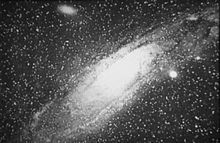
In 1917, Heber Curtis had observed the nova S Andromedae within the "Great Andromeda Nebula" (Messier object M31). Searching the photographic record, he found 11 more novae. Curtis noticed that these novae were, on average, 10 magnitudes fainter than those that occurred within our Galaxy. As a result he was able to come up with a distance estimate of 150,000 parsecs. He became a proponent of the "island universes" hypothesis, which held that the spiral nebulae were actually independent galaxies.[134] In 1920 the Great Debate took place between Harlow Shapley and Heber Curtis, concerning the nature of the Milky Way, spiral nebulae, and the dimensions of the universe. To support his claim that the Great Andromeda Nebula was an external galaxy, Curtis noted the appearance of dark lanes resembling the dust clouds in the Milky Way, as well as the significant Doppler shift.[135]
The matter was conclusively settled by Edwin Hubble in the early 1920s using the Mount Wilson observatory 100 inch (2.5 m) Hooker telescope. With the light-gathering power of this new telescope he was able to produce astronomical photographs that resolved the outer parts of some spiral nebulae as collections of individual stars. He was also able to identify some Cepheid variables that he could use as a benchmark to estimate the distance to the nebulae: proving they were far too distant to be part of the Milky Way.[136] In 1936, Hubble produced a classification system for galaxies that is used to this day, the Hubble sequence.[137]
See also
- Baade's Window
- Galactic coordinate system
- MilkyWay@Home, a distributed computing project that attempts to generate highly accurate three-dimensional dynamic models of stellar streams in the immediate vicinity of our Milky Way Galaxy.
- NGC 6744, a galaxy thought to closely resemble the Milky Way
- Oort constants
Notes
-
^ Jay M. Pasachoff in
his text book "Astronomy: From the Earth to the Universe" states the
term Milky Way should refer exclusively to the band of light
that the galaxy forms in the
night sky, while the galaxy should receive the full name
Milky Way Galaxy. See:
- Pasachoff, Jay M. (1994). Astronomy: From the Earth to the Universe. Harcourt School. p. 500. ISBN 0-03-001667-3.
- ^ See also Bortle Dark-Sky Scale
- ^ The scale is 1 mm equals 1 ly.
- ^ For a photo see: "Sagittarius A*: Milky Way monster stars in cosmic reality show". Chandra X-ray Observatory. Harvard-Smithsonian Center for Astrophysics. January 6, 2003. Retrieved 2012-05-20.
Reference
- ^ a b Gerhard, O. (2002). "Mass distribution in our Galaxy". Space Science Reviews 100 (1/4): 129–138. arXiv:astro-ph/0203110. Bibcode:2002astro.ph..3110G. doi:10.1023/A:1015818111633.
- ^ a b c Christian, Eric; Safi-Harb, Samar. "How large is the Milky Way?". NASA: Ask an Astrophysicist. Retrieved 2007-11-28.
- ^ a b Rix, Hans-Walter and Bovy, Jo (2013). "The Milky Way's Stellar Disk". Astron. Astrophys. Rev. in press. arXiv:1301.3168.
- ^ "NASA – Galaxy". NASA and World Book. Nasa.gov. November 29, 2007. Archived from the original on 2009-04-12. Retrieved 2012-12-06.
- ^ Staff (December 16, 2008). "How Many Stars are in the Milky Way?". Universe Today. Retrieved 2010-08-10.
- ^ a b c Frebel, A. et al. (2007). "Discovery of HE 1523-0901, a strongly r-process-enhanced metal-poor star with detected uranium". The Astrophysical Journal 660 (2): L117. arXiv:astro-ph/0703414. Bibcode:2007ApJ...660L.117F. doi:10.1086/518122.
- ^ a b McMillan, P. J. (July 2011). "Mass models of the Milky Way". Monthly Notices of the Royal Astronomical Society 414 (3): 2446–2457. Bibcode:2011MNRAS.414.2446M. doi:10.1111/j.1365-2966.2011.18564.x.
- ^ a b c d Gillessen, S. et al. (2009). "Monitoring stellar orbits around the massive black hole in the Galactic Center". Astrophysical Journal 692 (2): 1075–1109. arXiv:0810.4674. Bibcode:2009ApJ...692.1075G. doi:10.1088/0004-637X/692/2/1075.
- ^ a b Gunter Faure, Teresa M. Mensing, Introduction to Planetary Science: The Geological Perspective, page 45
- ^ a b Bissantz, N.; Englmaier, P.; Gerhard, O. (2003). "Gas dynamics in the Milky Way: second pattern speed and large-scale morphology". Monthly Notices of the Royal Astronomical Society 340 (3): 949. arXiv:astro-ph/0212516. Bibcode:2003MNRAS.340..949B. doi:10.1046/j.1365-8711.2003.06358.x.
- ^ a b c Kogut, A. et al. (1993). "Dipole anisotropy in the COBE differential microwave radiometers first-year sky maps". The Astrophysical Journal 419: 1. arXiv:astro-ph/9312056. Bibcode:1993ApJ...419....1K. doi:10.1086/173453.
- ^ "Milky Way". Oxford University Press. Retrieved 2012-10-31.
- ^ "Milky Way Galaxy". Merriam-Webster Incorportated. Retrieved 2012-10-31.
- ^ "Milky Way Galaxy". Encyclopædia Britannica, Inc. Retrieved 2012-10-31.
- ^ a b Harper, Douglas. "galaxy". Online Etymology Dictionary. Retrieved 2012-05-20.
- ^ Jankowski, Connie (2010). Pioneers of Light and Sound. Compass Point Books. p. 6. ISBN 0-7565-4306-1.
- ^ Schiller, Jon (2010). Big Bang & Black Holes. CreateSpace. p. 163. ISBN 1-4528-6552-3.
- ^ a b c Cassan, A. et al. (January 11, 2012). "One or more bound planets per Milky Way star from microlensing observations". Nature 481 (7380): 167–169. Bibcode:2012Natur.481..167C. doi:10.1038/nature10684. PMID 22237108.
- ^ a b Staff (January 2, 2013). "100 Billion Alien Planets Fill Our Milky Way Galaxy: Study". Space.com. Retrieved January 3, 2013.
- ^ a b c Koupelis, Theo; Kuhn, Karl F. (2007). In Quest of the Universe. Jones & Bartlett Publishers. p. 492; Figure 16-13. ISBN 0-7637-4387-9.
- ^ Pasachoff, Jay M. (1994). Astronomy: From the Earth to the Universe. Harcourt School. p. 500. ISBN 0-03-001667-3.
- ^ Steinicke, Wolfgang; Jakiel, Richard (2007). Galaxies and how to observe them. Astronomers' observing guides. Springer. p. 94. ISBN 1-85233-752-4.
- ^ "How Big is Our Universe: How far is it across the Milky Way?". NASA-Smithsonian Education Forum on the Structure and Evolution of the Universe, at the Harvard Smithsonian Center for Astrophysics. Retrieved March 13, 2013.
- ^ Villard, Ray (January 11, 2012). "The Milky Way Contains at Least 100 Billion Planets According to Survey". HubbleSite.org. Retrieved 2012-01-11.
- ^ Frommert, H.; Kronberg, C. (August 25, 2005). "The Milky Way Galaxy". SEDS. Retrieved 2007-05-09.
- ^ Wethington, Nicholos. "How Many Stars are in the Milky Way?". Retrieved 2010-04-09.
- ^ Young, Kelly (June 6, 2006). "Andromeda Galaxy hosts a trillion stars". NewScientist. Retrieved 2006-06-08.
- ^ Levine, E. S.; Blitz, L.; Heiles, C. (2006). "The spiral structure of the outer Milky Way in hydrogen". Science 312 (5781): 1773–1777. arXiv:astro-ph/0605728. Bibcode:2006Sci...312.1773L. doi:10.1126/science.1128455. PMID 16741076.
- ^ Dickey, J. M.; Lockman, F. J. (1990). "H I in the Galaxy". Annual Review of Astronomy and Astrophysics 28: 215. Bibcode:1990ARA&A..28..215D. doi:10.1146/annurev.aa.28.090190.001243.
- ^ Savage, B. D.; Wakker, B. P. (2009). "The extension of the transition temperature plasma into the lower galactic halo". The Astrophysical Journal 702 (2): 1472. Bibcode:2009ApJ...702.1472S. doi:10.1088/0004-637X/702/2/1472.
- ^ Borenstein, Seth (February 19, 2011). "Cosmic census finds crowd of planets in our galaxy". The Washington Post. Associated Press. Archived from the original on 2011-02-21.
- ^ Sumi, T. et al. (2011). "Unbound or distant planetary mass population detected by gravitational microlensing". Nature 473 (7347): 349–352. arXiv:1105.3544. Bibcode:2011Natur.473..349S. doi:10.1038/nature10092. PMID 21593867.
- ^ "Free-Floating Planets May be More Common Than Stars". Pasadena, CA: NASA's Jet Propulsion Laboratory. February 18, 2011. Archived from the original on 2011-05-25. "The team estimates there are about twice as many of them as stars."
- ^ a b Staff (January 7, 2013). "17 Billion Earth-Size Alien Planets Inhabit Milky Way". Space.com. Retrieved January 8, 2013.
- ^ Sale, S. E. et al. (February 2010). "The structure of the outer Galactic disc as revealed by IPHAS early a stars". Monthly Notices of the Royal Astronomical Society 402 (2): 713–723. Bibcode:2010MNRAS.402..713S. doi:10.1111/j.1365-2966.2009.15746.x.
- ^ Connors, Tim W.; Kawata, Daisuke; Gibson, Brad K. (2006). "N-body simulations of the Magellanic stream". Monthly Notices of the Royal Astronomical Society 371 (1): 108–120. arXiv:astro-ph/0508390. Bibcode:2006MNRAS.371..108C. doi:10.1111/j.1365-2966.2006.10659.x.
- ^ Coffey, Jerry. "Absolute Magnitude". Retrieved 2010-04-0.
- ^ Karachentsev, I. D.; Kashibadze, O. G. (2006). "Masses of the local group and of the M81 group estimated from distortions in the local velocity field". Astrophysics 49 (1): 3–18. Bibcode:2006Ap.....49....3K. doi:10.1007/s10511-006-0002-6.
- ^ Vayntrub, Alina (2000). "Mass of the Milky Way". The Physics Factbook. Retrieved 2007-05-09.
- ^ Battaglia, G. et al. (2005). "The radial velocity dispersion profile of the Galactic halo: Constraining the density profile of the dark halo of the Milky Way". Monthly Notices of the Royal Astronomical Society: 433–442. arXiv:astro-ph/0506102. Bibcode:2005MNRAS.364..433B. doi:10.1111/j.1365-2966.2005.09367.x.
- ^ Finley, Dave; Aguilar, David (January 5, 2009). "Milky Way a Swifter Spinner, More Massive, New Measurements Show". National Radio Astronomy Observatory. Retrieved 2009-01-20.
- ^ Reid, M. J. et al. (2009). "Trigonometric parallaxes of massive star-forming regions. VI. Galactic structure, fundamental parameters, and noncircular motions". The Astrophysical Journal 700: 137–148. arXiv:0902.3913. Bibcode:2009ApJ...700..137R. doi:10.1088/0004-637X/700/1/137.
- ^ Gnedin, O. Y. et al. (2010). "The mass profile of the Galaxy to 80 kpc". The Astrophysical Journal 720: L108. arXiv:1005.2619. Bibcode:2010ApJ...720L.108G. doi:10.1088/2041-8205/720/1/L108.
- ^
a
b
c
Benjamin, R. A. (2008). "The
Spiral Structure of the Galaxy: Something Old, Something New...". In
Beuther, H.; Linz, H.; Henning, T. (ed.). Massive Star Formation:
Observations Confront Theory 387. Astronomical Society of
the Pacific Conference Series. p. 375.
Bibcode:2008ASPC..387..375B.
See also Bryner, Jeanna (June 3, 2008). "New Images: Milky Way Loses Two Arms". Space.com. Retrieved 2008-06-04. - ^ Chen, W.; Gehrels, N.; Diehl, R.; Hartmann, D. (1996). "On the spiral arm interpretation of COMPTEL ^26^Al map features". Space Science Reviews 120: 315–316. Bibcode:1996A&AS..120C.315C.
- ^ McKee, Maggie (August 16, 2005). "Bar at Milky Way's heart revealed". New Scientist. Retrieved 2009-06-17.
- ^ a b c d Ghez, A. M. et al. (December 2008). "Measuring distance and properties of the Milky Way's central supermassive black hole with stellar orbits". The Astrophysical Journal 689 (2): 1044–1062. Bibcode:2008ApJ...689.1044G. doi:10.1086/592738.
- ^ Reid, M. J. et al. (November 2009). "A trigonometric parallax of Sgr B2". The Astrophysical Journal 705 (2): 1548–1553. Bibcode:2009ApJ...705.1548R. doi:10.1088/0004-637X/705/2/1548.
- ^ a b Vanhollebeke, E.; Groenewegen, M. A. T.; Girardi, L. (April 2009). "Stellar populations in the Galactic bulge. Modelling the Galactic bulge with TRILEGAL". Astronomy and Astrophysics 498: 95–107. Bibcode:2009A&A...498...95V. doi:10.1051/0004-6361/20078472.
- ^ a b c d Majaess, D. (March 2010). "Concerning the Distance to the Center of the Milky Way and Its Structure". Acta Astronomica 60 (1): 55. arXiv:1002.2743. Bibcode:2010AcA....60...55M.
- ^ Grant, J.; Lin, B. (2000). "The Stars of the Milky Way". Fairfax Public Access Corporation. Retrieved 2007-05-09.
- ^ Shen, J.; Rich, R. M.; Kormendy, J.; Howard, C. D.; De Propris, R.; Kunder, A. (2010). "Our Milky Way As a Pure-Disk Galaxy—A Challenge for Galaxy Formation". The Astrophysical Journal 720: L72. doi:10.1088/2041-8205/720/1/L72.
- ^ Jones, Mark H.; Lambourne, Robert J.; Adams, David John (2004). An Introduction to Galaxies and Cosmology. Cambridge University Press. pp. 50–51. ISBN 0-521-54623-0.
- ^ Blandford, R. D. (1999). "Origin and Evolution of Massive Black Holes in Galactic Nuclei". Galaxy Dynamics, proceedings of a conference held at Rutgers University, 8–12 August 1998, ASP Conference Series vol. 182. Bibcode:1999ASPC..182...87B.
- ^ Frolov, Valeri P.; Zelnikov, Andrei (2011). Introduction to Black Hole Physics. Oxford University Press. pp. 11, 36. ISBN 0199692297.
- ^ Cabrera-Lavers, A. et al. (December 2008). "The long Galactic bar as seen by UKIDSS Galactic plane survey". Astronomy and Astrophysics 491 (3): 781–787. Bibcode:2008A&A...491..781C. doi:10.1051/0004-6361:200810720.
- ^ Nishiyama, S. et al. (2005). "A distinct structure inside the Galactic bar". The Astrophysical Journal 621 (2): L105. arXiv:astro-ph/0502058. Bibcode:2005ApJ...621L.105N. doi:10.1086/429291.
- ^ Alcock, C. et al. (1998). "The RR Lyrae population of the Galactic Bulge from the MACHO database: mean colors and magnitudes". The Astrophysical Journal 492 (2): 190. arXiv:astro-ph/0502058. Bibcode:2005ApJ...621L.105N. doi:10.1086/305017.
- ^ Kunder, A.; Chaboyer, B. (2008). "Metallicity analysis of Macho Galactic Bulge RR0 Lyrae stars from their light curves". The Astronomical Journal 136 (6): 2441. Bibcode:2008AJ....136.2441K. doi:10.1088/0004-6256/136/6/2441.
- ^ Staff (September 12, 2005). "Introduction: Galactic Ring Survey". Boston University. Retrieved 2007-05-10.
- ^ a b Churchwell, E. et al. (2009). "The Spitzer/GLIMPSE surveys: a new view of the Milky Way". Publications of the Astronomical Society of the Pacific 121 (877): 213. Bibcode:2009PASP..121..213C. doi:10.1086/597811.
- ^ Taylor, J. H.; Cordes, J. M. (1993). "Pulsar distances and the galactic distribution of free electrons". The Astrophysical Journal 411: 674. doi:10.1086/172870.
- ^ a b c d Russeil, D. (2003). "Star-forming complexes and the spiral structure of our Galaxy". Astronomy and Astrophysics 397: 133–146. Bibcode:2003A&A...397..133R. doi:10.1051/0004-6361:20021504.
- ^ Dame, T. M.; Hartmann, D.; Thaddeus, P. (2001). "The Milky Way in Molecular Clouds: A New Complete CO Survey". The Astrophysical Journal 547 (2): 792. doi:10.1086/318388.
- ^ a b c Drimmel, R. (2000). "Evidence for a two-armed spiral in the Milky Way". Astronomy & Astrophysics 358: L13–L16. arXiv:astro-ph/0005241. Bibcode:2000A&A...358L..13D.
- ^ a b Benjamin, R. A. et al. (2005). "First GLIMPSE results on the stellar structure of the Galaxy". The Astrophysical Journal 630 (2): L149–L152. arXiv:astro-ph/0508325. Bibcode:2005ApJ...630L.149B. doi:10.1086/491785.
- ^ Nakanishi, Hiroyuki; Sofue, Yoshiaki (2003). "Three-Dimensional Distribution of the ISM in the Milky Way Galaxy: I. The H I Disk". Publications of the Astronomical Society of Japan 55: 191. arXiv:astro-ph/0304338. Bibcode:2003PASJ...55..191N.
- ^ Vallée, J. P. (2008). "New velocimetry and revised cartography of the spiral arms in the Milky Way—a consistent symbiosis". The Astronomical Journal 135 (4): 1301. Bibcode:2008AJ....135.1301V. doi:10.1088/0004-6256/135/4/1301.
- ^ Hou, L. G.; Han, J. L.; Shi, W. B. (2009). "The spiral structure of our Milky Way Galaxy". Astronomy and Astrophysics 499 (2): 473. Bibcode:2009A&A...499..473H. doi:10.1051/0004-6361/200809692.
- ^ a b c d Majaess, D. J.; Turner, D. J.; Lane (2009). "Searching Beyond the Obscuring Dust Between the Cygnus-Aquila Rifts for Cepheid Tracers of the Galaxy's Spiral Arms". The Journal of the American Association of Variable Star Observers 37: 179. arXiv:0909.0897. Bibcode:2009JAVSO..37..179M.
- ^ a b Lépine, J. R. D. et al. (2011). "The spiral structure of the Galaxy revealed by CS sources and evidence for the 4:1 resonance". Monthly Notices of the Royal Astronomical Society 414 (2): 1607. arXiv:1010.1790. Bibcode:2011MNRAS.414.1607L. doi:10.1111/j.1365-2966.2011.18492.x.
- ^ Alexander, S. (1852). "On the origin of the forms and the present condition of some of the clusters of stars, and several of the nebulae". The Astronomical Journal 2: 97. Bibcode:1852AJ......2...97A. doi:10.1086/100231.
- ^ Levine, E. S.; Blitz, L.; Heiles, C. (2006). "The spiral structure of the outer Milky Way in hydrogen". Science 312 (5781): 1773–1777. arXiv:astro-ph/0605728. Bibcode:2006Sci...312.1773L. doi:10.1126/science.1128455. PMID 16741076.
- ^ a b McClure-Griffiths, N. M.; Dickey, J. M.; Gaensler, B. M.; Green, A. J. (2004). "A Distant Extended Spiral Arm in the Fourth Quadrant of the Milky Way". The Astrophysical Journal 607 (2): L127. doi:10.1086/422031.
- ^ "Star-Crossed: Milky Way's Spiral Shape May Result from a Smaller Galaxy's Impact". Scientific American. 14 September 2011.
- ^ Harris, William E. (February 2003). "Catalog of Parameters for Milky Way Globular Clusters: The Database" (text). SEDS. Retrieved 2007-05-10.
- ^ Dauphole, B. et al. (September 1996). "The kinematics of globular clusters, apocentric distances and a halo metallicity gradient". Astronomy and Astrophysics 313: 119–128. Bibcode:1996A&A...313..119D.
- ^ Gnedin, O. Y.; Lee, H. M.; Ostriker, J. P. (1999). "Effects of Tidal Shocks on the Evolution of Globular Clusters". The Astrophysical Journal 522 (2): 935–949. arXiv:astro-ph/9806245. Bibcode:1999ApJ...522..935G. doi:10.1086/307659.
- ^ Boen, Brooke. "NASA's Chandra Shows Milky Way is Surrounded by Halo of Hot Gas09.24.12". Brooke Boen. Retrieved October 28, 2012.
- ^ Communications, Discovery. "OUR GALAXY SWIMS INSIDE A GIANT POOL OF HOT GAS". Discovery Communications. Retrieved October 28, 2012.
- ^ Ibata, R. et al. (2005). "On the accretion origin of a vast extended stellar disk around the Andromeda Galaxy". The Astrophysical Journal 634 (1): 287–313. arXiv:astro-ph/0504164. Bibcode:2005ApJ...634..287I. doi:10.1086/491727.
- ^ "Outer Disk Ring?". SolStation. Retrieved 2007-05-10.
- ^ Jurić, M. et al. (February 2008). "The Milky Way Tomography with SDSS. I. Stellar Number Density Distribution". The Astrophysical Journal 673 (2): 864–914. Bibcode:2008ApJ...673..864J. doi:10.1086/523619.
- ^ a b J.D. Harrington, Janet Anderson, and Peter Edmonds (September 24, 2012). "NASA's Chandra Shows Milky Way is Surrounded by Halo of Hot Gas". NASA.
- ^ Gupta, A.; Mathur, S.; Krongold, Y.; Nicastro, F.; Galeazzi, M. (2012). "A Huge Reservoir of Ionized Gas Around the Milky Way: Accounting for the Missing Mass?". The Astrophysical Journal 756: L8. arXiv:1205.5037. doi:10.1088/2041-8205/756/1/L8.
- ^ "Galactic Halo: Milky Way is Surrounded by Huge Halo of Hot Gas". Smithsonian Astrophysical Observatory. September 24, 2012.
- ^ Overbye, Dennis (November 9, 2010). "Bubbles of Energy Are Found in Galaxy". The New York Times.
- ^ "Rätselhafte Blasen im All". Süddeutsche Zeitung. Retrieved 2010-11-10.
- ^ Reid, M. J. (1993). "The distance to the center of the Galaxy". Annual Review of Astronomy and Astrophysics 31: 345–372. Bibcode:1993ARA&A..31..345R. doi:10.1146/annurev.aa.31.090193.002021.
- ^ Majaess, D. J.; Turner, D. G.; Lane, D. J. (2009). "Characteristics of the Galaxy according to Cepheids". Monthly Notices of the Royal Astronomical Society 398 (1): 263–270. Bibcode:2009MNRAS.398..263M. doi:10.1111/j.1365-2966.2009.15096.x.
- ^ English, Jayanne (January 14, 2000). "Exposing the Stuff Between the Stars". Hubble News Desk. Retrieved 2007-05-10.
- ^ Gillman, M.; Erenler, H. (2008). "The galactic cycle of extinction". International Journal of Astrobiology 7. Bibcode:2008IJAsB...7...17G. doi:10.1017/S1473550408004047.
- ^ Overholt, A. C.; Melott, A. L.; Pohl, M. (2009). "Testing the link between terrestrial climate change and galactic spiral arm transit". The Astrophysical Journal 705 (2): L101–L103. Bibcode:2009ApJ...705L.101O. doi:10.1088/0004-637X/705/2/L101.
- ^ Leong, Stacy (2002). "Period of the Sun's Orbit around the Galaxy (Cosmic Year)". The Physics Factbook. Retrieved 2007-05-10.
- ^ Garlick, Mark Antony (2002). The Story of the Solar System. Cambridge University. p. 46. ISBN 0-521-80336-5.
- ^ Peter Schneider (2006). Extragalactic Astronomy and Cosmology. Springer. p. 4, Figure 1.4. ISBN 3-540-33174-3.
- ^ Jones, Mark H.; Lambourne, Robert J.; Adams, David John (2004). An Introduction to Galaxies and Cosmology. Cambridge University Press. p. 21; Figure 1.13. ISBN 0-521-54623-0.
- ^ Imamura, Jim (August 10, 2006). "Mass of the Milky Way Galaxy". University of Oregon. Archived from the original on 2007-03-01. Retrieved 2007-05-10.
- ^ Peter Schneider (2006). Extragalactic Astronomy and Cosmology. Springer. p. 413. ISBN 3-540-33174-3.
- ^ Wethington, Nicholas (May 27, 2009). "Formation of the Milky Way". Universe Today.
- ^ a b Buser, R. (2000). "The Formation and Early Evolution of the Milky Way Galaxy". Science 287 (5450): 69–74. Bibcode:2000Sci...287...69B. doi:10.1126/science.287.5450.69. PMID 10615051.
- ^ Wakker, B. P.; Van Woerden, H. (1997). "High-Velocity Clouds". Annual Review of Astronomy and Astrophysics 35: 217. Bibcode:1997ARA&A..35..217W. doi:10.1146/annurev.astro.35.1.217.
- ^ Lockman, F. J. et al. (2008). "The Smith Cloud: A High-Velocity Cloud Colliding with the Milky Way". The Astrophysical Journal 679: L21–L24. arXiv:0804.4155. Bibcode:2008ApJ...679L..21L. doi:10.1086/588838.
- ^ Yin, J.; Hou, J.L; Prantzos, N.; Boissier, S.; Chang, R. X.; Shen, S. Y.; Zhang, B. (2009). "Milky Way versus Andromeda: a tale of two disks". Astronomy and Astrophysics 505 (2): 497–508. arXiv:0906.4821. Bibcode:2009A&A...505..497Y. doi:10.1051/0004-6361/200912316.
- ^ Hammer, F.; Puech, M.; Chemin, L.; Flores, H.; Lehnert, M. D. (2007). "The Milky Way, an Exceptionally Quiet Galaxy: Implications for the Formation of Spiral Galaxies". The Astrophysical Journal 662 (1): 322–334. arXiv:astro-ph/0702585. Bibcode:2007ApJ...662..322H. doi:10.1086/516727.
- ^ Mutch, S.J.; Croton, D.J.; Poole, G.B. (2011). "The Mid-life Crisis of the Milky Way and M31". The Astrophysical Journal 736 (2). arXiv:1105.2564. Bibcode:2011ApJ...736...84M. doi:10.1088/0004-637X/736/2/84.
- ^ Licquia, T.; Newman, J.A.; Poole, G.B. (2012). "What Is The Color Of The Milky Way?". American Astronomical Society. Bibcode:2012AAS...21925208L.
- ^ Cayrel et al (2001). "Measurement of stellar age from uranium decay". Nature 409: 691. arXiv:astro-ph/0104357. Bibcode:2001Natur.409..691C.
- ^ "Estimating the Age of the Milky Way". Retrieved 2013-06-10. . Universetoday.com (2004-08-22). Retrieved on 2013-06-10.
- ^ Krauss, L. M.; Chaboyer, B. (2003). "Age Estimates of Globular Clusters in the Milky Way: Constraints on Cosmology". Science 299 (5603): 65–69. Bibcode:2003Sci...299...65K. doi:10.1126/science.1075631. PMID 12511641.
- ^ Del Peloso, E. F. (2005). "The age of the Galactic thin disk from Th/Eu nucleocosmochronology". Astronomy and Astrophysics 440 (3): 1153. arXiv:astro-ph/0506458. Bibcode:2005A&A...440.1153D. doi:10.1051/0004-6361:20053307.
- ^ "Milky Way Galaxy is warped and vibrating like a drum" (Press release). University of California, Berkeley. January 9, 2006. Retrieved 2007-10-18.
- ^ Wong, Janet (April 14, 2000). "Astrophysicist maps out our own galaxy's end". University of Toronto. Archived from the original on 2007-01-08. Retrieved 2007-01-11.
- ^ Mark H. Jones, Robert J. Lambourne, David John Adams (2004). An Introduction to Galaxies and Cosmology. Cambridge University Press. p. 298. ISBN 0-521-54623-0.
- ^ Kocevski, D. D.; Ebeling, H. (2006). "On the origin of the Local Group's peculiar velocity". The Astrophysical Journal 645 (2): 1043–1053. arXiv:astro-ph/0510106. Bibcode:2006ApJ...645.1043K. doi:10.1086/503666.
- ^ Peirani, S; Defreitaspacheco, J (2006). "Mass determination of groups of galaxies: Effects of the cosmological constant". New Astronomy 11 (4): 325. arXiv:astro-ph/0508614. Bibcode:2006NewA...11..325P. doi:10.1016/j.newast.2005.08.008.
- ^ Jankowski, Connie (2010). Pioneers of Light and Sound. Compass Point Books. p. 6. ISBN 0-7565-4306-1.
- ^ Schiller, Jon (2010). Big Bang & Black Holes. CreateSpace. p. 163. ISBN 1-4528-6552-3.
- ^ Simpson, John; Weiner, Edmund, eds. (March 30, 1989). The Oxford English Dictionary (2nd ed.). Oxford University Press. ISBN 0198611862. See the entries for "Milky Way" and "galaxy".
- ^ Eratosthenes (1997). Condos, Theony, ed. Star Myths of the Greeks and Romans: A Sourcebook Containing the Constellations of Pseudo-Eratosthenes and the Poetic Astronomy of Hyginus. Red Wheel/Weiser. ISBN 1890482935.
- ^ Waller, William H.; Hodge, Paul W. (2003). "The Milky Way". Galaxies and the Cosmic Frontier. Harvard University Press. p. 91. ISBN 0-674-01079-5.
- ^ Fison, Alfred H. (1899). Recent Advances in Astronomy. Victorian era series. H. S. Stone. p. 49.
- ^ Jackson, A. M. T.; Enthoven, R. E. (1989). Folk Lore Notes. Asian Educational Services. ISBN 81-206-0485-7. "... According to the Puranas, the milky way or akashganga is the celestial River Ganga which was brought down by Bhagirath ..."
- ^ Spencer, Hormusjee Shapoorjee (1965). The Aryan ecliptic cycle: glimpses into ancient Indo-Iranian religious history from 25628 B.C. to 292 A.D.. H. P. Vaswani. "... There are two "Gangas"—one terrestrial and the other "akashic" or celestial ... bear reference only to the "Akash Ganga" which is the Milky Way ..."
- ^ Sachau, Edward C. (2001). Alberuni's India: an account of the religion, philosophy, literature, geography, chronology, astronomy, customs, laws and astrology of India about A.D. 1030. Routledge. ISBN 978-0-415-24497-8. "... revolves around Kshira, i.e. the Milky Way ..."
- ^ a b Montada, Josep Puig (September 28, 2007). "Ibn Bajja". Stanford Encyclopedia of Philosophy. Retrieved 2008-07-11.
- ^ Heidarzadeh, Tofigh (2008). A history of physical theories of comets, from Aristotle to Whipple. Springer. pp. 23–25. ISBN 1-4020-8322-X.
- ^ O'Connor, John J.; Robertson, Edmund F., "Abu Rayhan Muhammad ibn Ahmad al-Biruni", MacTutor History of Mathematics archive, University of St Andrews .[unreliable source?]
- ^ Livingston, John W. (1971). "Ibn Qayyim al-Jawziyyah: A Fourteenth Century Defense against Astrological Divination and Alchemical Transmutation". Journal of the American Oriental Society (American Oriental Society) 91 (1): 96–103 [99]. doi:10.2307/600445. JSTOR 600445.
- ^ Ragep, Jamil (1993). Nasir al-Din al-Tusi’s Memoir on Astronomy (al-Tadhkira fi `ilm al-hay’ a). New York: Springer-Verlag. p. 129.
- ^ O'Connor, J. J.; Robertson, E. F. (November 2002). "Galileo Galilei". University of St. Andrews. Retrieved 2007-01-08.
- ^ Evans, J. C. (November 24, 1998). "Our Galaxy". George Mason University. Retrieved 2007-01-04.
- ^ Abbey, Lenny. "The Earl of Rosse and the Leviathan of Parsontown". The Compleat Amateur Astronomer. Retrieved 2007-01-04.
- ^ Curtis, H. D. (1988). "Novae in spiral nebulae and the Island Universe Theory". Publications of the Astronomical Society of the Pacific 100: 6–2. Bibcode:1988PASP..100....6C. doi:10.1086/132128.
- ^ Weaver, Harold F. "Robert Julius Trumpler". National Academy of Sciences. Retrieved 2007-01-05.
- ^ Hubble, E. P. (1929). "A spiral nebula as a stellar system, Messier 31". The Astrophysical Journal 69: 103–158. Bibcode:1929ApJ....69..103H. doi:10.1086/143167.
- ^ Sandage, Allan (1989). "Edwin Hubble, 1889–1953". Journal of the Royal Astronomical Society of Canada 83 (6). Bibcode:1989JRASC..83..351S. Retrieved 2007-01-08.
Further reading
- Thorsten Dambeck in Sky and Telescope, "Gaia's Mission to the Milky Way", March 2008, p. 36–39.
- Cristina Chiappini, The Formation and Evolution of the Milky Way, American Scientist, November/December 2001, pp. 506–515
External links
|
|
Wikimedia Commons has media related to: Milky Way Galaxy |
- 3D Galaxy Map - a 3D representation of the Milky Way galaxy
- Basic Milky Way plan map - includes spiral arms and Orion spur
- Milky Way – IRAS (infrared) survey - wikisky.org
- Milky Way – H-Alpha survey - wikisky.org
- The Milky Way Galaxy - SEDS Messier website
- MultiWavelength Milky Way - NASA site with images and VRML models
- Milky Way Explorer - images in infrared with radio, microwave and hydrogen-alpha.
- Milky Way Panorama (9 billion pixels).
- Milky Way Video (02:37) - VISTA IR Telescope Image (October 24, 2012)
- Animated tour of the Milky Way, University of South Wales
- all-sky map of microwave radiation (Planck (spacecraft) one-year all-sky survey)
|
|||||||||||||||||||||||||||||||
|
||
WOMAN WITH CHILD:
-
THE WOMAN WITH CHILD - THE BIRTH IS IMMINENT
www.greatdreams.com/constellations/birth_of_a_new_age.htm6-4-08 - DREAM - I was working in an apartment complex office as a rental agent. A large group of people came in to rent an apartment. They had seven infants ... -
DREAMS OF END OF THE AGE - Dreams of the Great Earth Changes
www.greatdreams.com/endage.htmThey are often associated with goddess figures, such as the Woman With Child in Revelation 12, the pregnant earth goddess "Serpent Skirt" in the Aztec myth, ... -
DREAMS ABOUT THE TRIPLE GODDESSES
www.greatdreams.com/drmgds.htmThis is "The Woman With Child," in Revelation 12, I think. In "Isis Unveiled," vol. 2, Blavatsky said the Woman in Rev. 12 is "Isis." The "little girl," and "washing" is ...You've visited this page 4 times. Last visit: 6/25/09 -
THE MOON IS TOO TOO BRIGHT - BACTERIA ON THE MOON
www.greatdreams.com/moon/bacteria.htmIn my view, the Shekinah is the Woman With Child in Revelation 12, wearing a crown of 12 stars, and clothed by the sun, with the moon under her feet. -
Revelation 11:11 - Humanity On The Pollen Path - Part II
www.greatdreams.com/11_11b.htmShe is made pregnant by feathers floating down from Heaven, and evil forces try to destroy the unborn child. This is much like the Woman With Child in Rev. 12. -
The Symbolism and Spiritual Significance of the Number Three
www.greatdreams.com/three/three.htmAn ideogram that represents a woman with child, from the sign for woman. This sign is ... It is a combination of the signs for woman, man, and woman with child.You've visited this page 3 times. Last visit: 11/1/10 -
THE CUT AND BANDED TREE - PART II
www.greatdreams.com/sacred/cut-banded-tree-two.htmMay 9, 2009 – IVP New Testament Commentaries are made available by the generosity of InterVarsity Press. THE WOMAN WITH CHILD IN THE BIBLE ... -
TAMASISK - ANGER - FURY - Dreams of the Great Earth Changes
The earth came to help the woman with child, by swallowing the river which poured out of the mouth of the dragon. When I first read this about five years ago,... -
WOLF SYMBOLISM - PART II - Dreams of the Great Earth Changes
The earth came to help the woman with child, by swallowing the river which poured out of the mouth of the dragon. When I first read this about five years ago,... -
DREAMS AND MYTHOLOGY OF CATS AND OTHER FELINES
The leap to the fourth - Heart chakra seems to be suggested by the twelve stars on the crown of The Woman With Child of Rev. 12:1, and by The New Jerusalem...
-
KARMA IN THE BIBLE - Dreams of the Great Earth Changes
woman with child in Revelation 12, as does Our Lady of Guadalupe, the miraculous image that appeared on the cloak of an Aztec Indian in 1531, in the same ...
-
11:11 AND IT'S CONNECTION TO REVELATION 11:11
This is indicated in Revelation 12 by the Woman With Child with twelve stars as a crown, and in Revelation 21 by the New Jerusalem, which has twelve gates, ...
-
THE SYMBOLISM AND SPIRITUAL SIGNIFICANCE OF 144 and 128 ...
Also interesting, The Woman with Child in Revelation 12 has a crown of 12 stars. The New Jerusalem has 12 gates, angels, jewels and pearls. The symbol of the ...
-
THE GEMATRIAN THEORY OF THE AGES
In Revelation, it's the woman with child in Revelation 12 who replaces he ... The woman with child has 12 stars as a crown, indicating this, as does the New ...
-
Dee Finney's blog April 20, 2012 page 203 THE WARRING CYCLE ...
Apr 20, 2012 – The earth came to help the woman with child, by swallowing the river which ... In Revelation, the harlot is replaced by The Woman With Child in ...
-
DREAMS OF BASEBALL GAMES WITH INTERPRETATION
To me, this relates to the child of the "Woman With Child" in Revelation 12. It also fits with the Son of Man in Revelation 1:13. The double edged sword issues ...
-
Humanity On The Pollen Path - Part One
After speaking of the woman with child, and the dragon that waits to devour her child, Revelation 12:6 continues . . . "and the woman fled into the wilderness, ... -
DREAMS OF THE MOVIE AND TV THEATRES
They are often associated with goddess figures, such as the Woman With Child in Revelation 12, the pregnant earth goddess "Serpent Skirt" in the Aztec myth, ...
-
DREAMS OF AWAKENING - Dreams of the Great Earth Changes
She is Woman With Child in Revelation 12, in my theory. Ishtar's time in the underworld seems to correspond to the symbolism of the harlot in Revelation 17, and ... -
THE BRIDESMAIDS COMETH - Dreams of the Great Earth Changes
The Woman With Child of Revelation 12 wears a crown of ... are named after the original concept of the planets, that included ... www.greatdreams.com/11coin7.
-
DREAMS OF SKY EVENTS - Dreams of the Great Earth Changes
In my view, the Shekinah is the Woman With Child in Revelation 12, wearing a crown of 12 stars, and clothed by the sun, with the moon under her feet. -
The Bee-Hive Crop Circle Formation
Jul 26, 2004 – I believe the Woman with Child is related to Mother Goddess figures in many mythologies, such as Isis, Ishtar, Sakti, Sophia, Shekinah, etc.
-
TWO SUNS - Dreams of the Great Earth Changes
The "large mastiff" in the theory is Canis Major/Sirius/Isis, which corresponds to the Woman With Child in Revelation 12. This is speaking of dreams, visions, ... -
CROP CIRCLE FORMATIONS AS CHAKRAS - Part One
Jan 1, 2000 – The energy of the new cycle seems to be represented by The Woman With Child in Revelation 12. She wears a crown of 12 stars.
-
TIME CYCLE DATABASE - Dreams of the Great Earth Changes
Revelation 12 has the Woman With Child, who is taken to a place for the 3 1/2 time cycle. 1260 days = 3 1/2 years on the Jewish calendar and "a time, .
-
THE RAINBOW OF CREATION - Dreams of the Great Earth Changes
Dec 27, 1999 – The 12 stars on the crown of the Woman With Child in Revelation 12, and The New Jerusalem in Revelation 21, also suggest the heart chakra.
-
dreams and articles about royalty, prince william, princess diana
I believe this is actually a transformation of Kali into her true position as Queen of Heaven, symbolised by the Woman With Child in Revelation
-
MESSAGE FROM HEAVEN - 3-23-98
Mar 23, 1998 – In Revelation 12, The woman With Child comes down, wearing a crown of 12 stars. Rev. 12:12 speaks of the devil coming down to earth ...
-
COINCIDENCE AND 11:11 - Dreams of the Great Earth Changes
This is indicated in Revelation 12 by the Woman With Child with twelve stars as a crown, and in Revelation 21 by the New Jerusalem, which has twelve gates, ...
-
DREAMS - SNAKES - Dreams of the Great Earth Changes
I believe this is actually a transformation of Kali into her true position as Queen of Heaven, symbolised by the Woman With Child in Revelation
-
Dee Finney's blog September 5, 2012 page 288 THE END OF THE ...
Sep 5, 2012 – The earth came to help the woman with child, by swallowing the river which ... In Revelation, the harlot is replaced by The Woman With Child in ...
-
BREAD FROM THE BIBLE - Dreams of the Great Earth Changes
Joe Mason states on his CROP CIRCLE FORMATIONS AS CHAKRAS page "The energy of the new cycle seems to be represented by The Woman With Child in ... -
19 GREAT WOMEN WRITERS - Dreams of the Great Earth Changes
May 17, 2005 – Revelation 12 has the Woman With Child, who is taken to a place for the 3 1/2 ... Revelation 12:1 - "And there appeared a great wonder in ... -
REVELATION 9:16 - THE WARRIORS COMETH - ARMEGEDDON
Jan 10, 2000 – (3) For when they shall say, Peace and safety; then sudden destruction shall come against them, as travail upon a woman with child; and they ...
-
the code of carl munck, and ancient gematrian numbers - part four
The next cycle seems to be related to the number 12, such as the crown of twelve stars worn by the Woman With Child in Revelation 12, the twelve ...
-
BLUE SPADES - Dreams of the Great Earth Changes
This may be indicated by the twelve stars of the Woman With Child in Revelation 12, and by the New Jerusalem in Revelation 21, which has twelve angels, ... -
Humanity On The Pollen Path - Part Six
Jul 26, 2004 – The Woman With Child in Revelation 12 also seems to symbolise the Goddess. ... The Woman With Child has a crown of twelve stars, perhaps ...
-
1260 - Chandra Levy Address - The Connection to Revelation?
Jul 15, 2001 – Revelation 12 has the Woman With Child, who is taken to a place for the 3 1/2 time cycle. 1260 days = 3 1/2 years on the Jewish calendar and ... -
COINCIDENCE AND 11:11 - PART IV
The great change, symbolically is given as the "death" or end of the harlot/Kali, and the downcoming of The Woman With Child of Revelation -
REVELATION OF THE TRUE SATAN
The student of Lepsius, Champollion, and other Egyptologists will quickly recognize Isis as the "woman with child," "clothed with the Sun and with the Moon...
-
The Cycle of Time Number 432 - Dreams of the Great Earth Changes
Also interesting, The Woman with Child in Revelation 12 has a crown of 12 stars. The New Jerusalem has 12 gates, angels, jewels and pearls. The symbol of the ... -
ECLIPSE - THE DREAM CONNECTION
This seems to point to The Woman With Child in Rev. 12, clothed with the sun, and the moon under her feet. The image, called, "Our Lady of Guadalupe," is still... -
Dee Finney's blog December 15, 2012 ALIEN DNA?
Dec 15, 2012 – This is indicated in Revelation 12 by the Woman With Child with twelve stars as a crown, and in Revelation 21 by the New Jerusalem, which ... -
Dee Finney's blog December 30, 2012 PAGE 414 VATICAN ...
Dec 30, 2012 – For when they shall say, Peace and safety; then sudden destruction cometh upon them, as travail upon a woman with child; and they shall not ... -
DREAMS OF TREES AND THE TRUTH THEY TELL
They are often associated with goddess figures, such as the Woman With Child in Revelation 12, the pregnant earth goddess "Serpent Skirt" in the Aztec myth, ... -
COINCIDENCE AND 11:11 - PART III
She and all the other Mother Goddesses of many names, I belive, are the same as The Woman with Child in Revelation 12. Some VERY coincidental dreams ... -
DREAMS AND VISIONS ABOUT KALI
I believe this is actually a transformation of Kali into her true position as Queen of Heaven, symbolised by the Woman With Child in Revelation 12. We will have ... -
EAT, DRINK, AND BE MERRY, FOR TOMRROW WE DIE
Jun 13, 2010 – The energy of the new cycle seems to be represented by The Woman With Child in Revelation 12. She wears a crown of 12 stars. The New ... -
The American Tragedy: A Symbolic Event, Part Two
12:16 the earth came to help the woman with child) One day, while performing her domestic duties, some downy feathers floated down from above. She tucked... -
CROP CIRCLE FORMATIONS AS CHAKRAS - PART 2
Apr 8, 2001 – This may be indicated by the twelve stars of the Woman With Child in Revelation 12, and by the New Jerusalem in Revelation 21, which has ...
-
Communion 2012 - The Stunning Noosphere Meaning - The Cosmic ...
May 22, 2008 – The leap to the fourth - Heart chakra seems to be suggested by the twelve stars on the crown of The Woman With Child of Rev. 12:1, and by ... -
The Interrelated 2005 Crop Circle Formations - Part Eight
The leap to the fourth - Heart chakra seems to be suggested by the twelve stars on the crown of The Woman With Child of Rev. 12:1, and by The New Jerusalem... -
Dee Finney's blog September 23, 2012 page 310 THE EYE OF ...
Sep 23, 2012 – THE WOMAN WITH CHILD - THE BIRTH IS IMMINENT. www.greatdreams.com/constellations/birth_of_a_new_age.htm
-
COMETS INCOMING - Dreams of the Great Earth Changes
to the Woman With Child in Revelation 12. This is speaking of dreams, visions, inspirations, etc., the communication from the collective unconscious at the end -
THE NEXT POPE - THE ANTI-POPE - THE HANGED MAN
Sep 30, 2004 – This is the Woman With Child of Revelation 12. The interpretation of the Hanged Man Tarot card given on the above linked Interactive Tree of ... -
Dee Finney's blog - March 21, 2012 - page 177 - GOLD BULLET ...
Mar 21, 2012 – The earth came to help the woman with child, by swallowing the river which ... In Revelation, the harlot is replaced by The Woman With Child in ...You visited this page on 6/18/13. -
Dee Finney's blog January 26, 2012 page 114 THE MATRIX
Jan 26, 2012 – THE WOMAN WITH CHILD - THE BIRTH IS IMMINENT. The way the brain processes "light" as information is closely analogous to the process ... -
11:11 - The Audio - Interview of Joseph Mason
www.greatdreams.com/radio/ryan/1111/ryan1111.htmThe leap to the fourth - Heart chakra seems to be suggested by the twelve stars on the crown of The Woman With Child of Rev. 12:1, and by The New Jerusalem... -
Dee Finney's blog - April 3, 2012 - page 187 - THE SEXUALITY OF ...
Apr 3, 2012 – THE WOMAN WITH CHILD - THE BIRTH IS IMMINENT. www.greatdreams.com/constellations/birth_of_a_new_age.htm -
The American Tragedy: A Symbolic Event, Part One
Sep 11, 2001 – The serpent poured water like a river out of his mouth after the woman [with child], to sweep her away with the flood. But the earth came to the ...
-
The 2006 Crop Circle Formations - Part One
www.greatdreams.com/crop/2006ccs/2006ccs.htmJul 28, 2006 – The leap to the fourth - Heart chakra seems to be suggested by the twelve stars on the crown of The Woman With Child of Rev. 12:1, and by ... -
DEE FINNEY's BLOG - OCTOBER 1, 2011 PAGE 50 - IOSOUS AND ...
Oct 1, 2011 – (3) For when they shall say, Peace and safety; then sudden destruction shall come against them, as travail upon a woman with child; and they ...
-
11:11 COINCIDENCES - DREAMS - EXPERIENCES FROM 2002
The Woman With Child of Revelation 12 wears a crown of twelve stars. The New Jerusalem has twelve gates, pearls, angels, and gems. These correspond to ... -
Dee Finney\s blog May 27, 2012 page 225 TIME TO SAY GOODBYE ...
May 27, 2012 – THE WOMAN WITH CHILD - THE BIRTH IS IMMINENT http://www.greatdreams.com/constellations/birth_of_a_new_age.htm
-
Dee Finney'd blog - December 9, 2011 - page 79 - BOOK OF RULES
www.greatdreams.com/blog/dee-blog79.htmlDec 9, 2011 – THE WOMAN WITH CHILD - THE BIRTH IS IMMINENT. Fact is that there are universal laws of order that govern all ... In the biblical book of ... -
Dee Finney's blog April 24, 2012 page 205 THE SUN AND PLANET X
www.greatdreams.com/blog-2012/dee-blog205.htmlFeb 23, 2012 – THE WOMAN WITH CHILD - THE BIRTH IS IMMINENT. Nibiru and probably Planet X and another one - Planet Y? Planet X and Planet Y
-
THE WOMAN WITH CHILD - THE BIRTH IS IMMINENT
Jun 4, 2008 – The student of Lepsius, Champollion, and other Egyptologists will quickly recognize Isis as the "woman with child," "clothed with the Sun and ... -
Isis Unveiled by H. P. Blavatsky, vol 2, ch 10, part 1
www.theosociety.org/pasadena/isis/iu2-10a.htm[[Vol. 2, Page]] 489 A NECESSARY AND LONG-DEFERRED EXPLANATION. quickly recognize Isis as the "woman with child," "clothed with the Sun and with the ...
Universe, Earth and Man: Lecture II: Ancient Wisdom and the new ...
-
[PDF]Egypt1: Isis - Fellowship of Isis
www.fellowshipofisis.com/ldr4_isis.pdfquickly recognise Isis as the 'woman with child', 'clothed with the Sun and with the Moon under her feet'. . and. .'two wings of a Great Eagle that she might fly into ... -
isis :: Reader comments at Daniel Pipes
Jun 25, 2009 – isis :: Reader comments at Daniel Pipes. ... here that I found that someone mentioned how a friend that he knew was using a woman with child.
-
Almighty God As The Return Of Isis The Black Virgin & Her ... - Multiply
josephalmighty.multiply.com/.../Almighty-God-As-The-Return-Of-Isis-Jun 24, 2009 – Almighty God As The Return Of Isis The Black Virgin & Her Firstborn Son .... as travail upon a WOMAN with child; and they shall not escape. -
The Birth of Jesus - Virgin Birth - Congregation Orah Saddiqim
www.orahsaddiqim.org/.../The_Birth_of_Jesus_-_Virgin_Birth.shtmlThe Egyptian God Horus was born of the virgin Isis; as an infant, he was visited by three kings. ... James Moffatt Translation: "...a young woman with child..."
Revelation 12:1-17, The woman and the dragon | Welcome to St ...
Secret Doctrine-by H.P.Blavatsky - Volume 3- Part 2 of 4
LADY GAGA DOES IT AGAIN
http://mysteryoftheiniquity.com/satans-tunes/lady-gaga-judas/
COLLIDING GALAXIES:
The Andromeda–Milky Way collision is a
galaxy collision predicted to occur in about 4
Stellar collisions
While the Andromeda Galaxy contains about 1 trillion (1012)
stars and the
Milky Way contains about 300 billion (3×1011), the
chance of even two stars colliding is negligible because of the huge
distances between the stars. For example, the nearest star to the
Sun is
Proxima Centauri, about 4.2 light-years (4.0×1013 km;
2.5×1013 mi) or 30 million (3×107)
solar
Black hole collisions
The Milky Way and Andromeda galaxies each contain a central supermassive black hole, these being Sagittarius A* (ca. 3.6 x 106 solar masses) and an object within the P2 concentration of Andromeda's nucleus (1-2 x 108 solar masses). These black holes will converge near the center of the newly formed galaxy, transferring orbital energy to stars that will be moved to higher orbits by gravitationally interacting with them, in a process that may take millions of years. When they come within one light year of one another, they will emit gravity waves that will radiate further orbital energy until they merge completely. Gas taken up by the combined black hole could create a luminous quasar or an active galactic nucleus. As of 2006, simulations indicated that the future Earth might be brought near the center of the combined galaxy, potentially coming near one of the black holes before being ejected entirely out of the galaxy.
The quasar, if it were to be created at the center of the Andromeda Galaxy, would be visible from Earth, and would be as bright as the Full Moon despite being 10,000 light years away. Its accretion disk would not be visible and it would appear as a blinking star due to atmospheric fluctuations. However, if a quasar were to be created at the center of the Milky Way, it would not be visible due to the dust between Earth and the galactic center. A quasar at the center of the Andromeda Galaxy would be brighter than one at the center of the Milky Way since the black hole at the center of Andromeda is larger than the Milky Way galactic center black hole.
Certainty
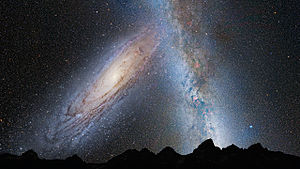
Up to 2012, there was no way to know whether the possible collision was definitely going to happen or not.[9] In 2012, researchers came to the conclusion that the collision is definite after using the Hubble Space Telescope between 2002 and 2010 to track the motion of Andromeda.[1] Such collisions are relatively common. Andromeda, for example, is believed to have collided with at least one other galaxy in the past,[10] and several dwarf galaxies such as SagDEG are currently colliding with the Milky Way and being merged into it.
These studies also suggest that M33, the Triangulum Galaxy – the third largest and brightest galaxy of the Local Group – will participate in this event. Its most likely fate is to end up orbiting the merger remnant of the Milky Way and Andromeda galaxies to merge with it in an even farther future, but a collision with the Milky Way before our galaxy collides with M31 or being ejected from the Local Group cannot be ruled out.[11]
The fate of the Solar System
Two scientists with the Harvard–Smithsonian Center for Astrophysics stated that when, and even whether, the two galaxies collide will depend on Andromeda's transverse velocity.[2] Based on current calculations they predict a 50% chance that in a merged galaxy the solar system will be swept out three times farther from the galactic core than it is currently located.[2] They also predict a 12% chance that the Solar System will be ejected from the new galaxy some time during the collision.[12] Such an event would have no adverse effect on the system and the chances of any sort of disturbance to the Sun or planets themselves may be remote.[12][13]
Without intervention, by the time that the two galaxies collide, the surface of the Earth will have already become far too hot for liquid water to exist, ending all terrestrial life, which is currently estimated to occur in about 1.4 billion years due to gradually increasing luminosity of the Sun.[14][15]
Possible triggered stellar events
When two spiral galaxies collide, the hydrogen present on their disks is compressed producing strong star formation as can be seen on interacting systems like the Antennae Galaxies. In the case of the Andromeda–Milky Way collision, it's believed that there will be little gas remaining in the disks of both galaxies, so the mentioned starburst will be relatively weak, though it still may be enough to form a quasar.[13]
Merger remnant
The galaxy product of the collision has been nicknamed Milkomeda or Milkdromeda. According to simulations, this object will look like a giant elliptical galaxy, but with a center showing less stellar density than current elliptical galaxies.[13]
In the far future the remaining galaxies of the Local Group will coalesce into this object, being the final evolutionary stage of our group of galaxies.[16]
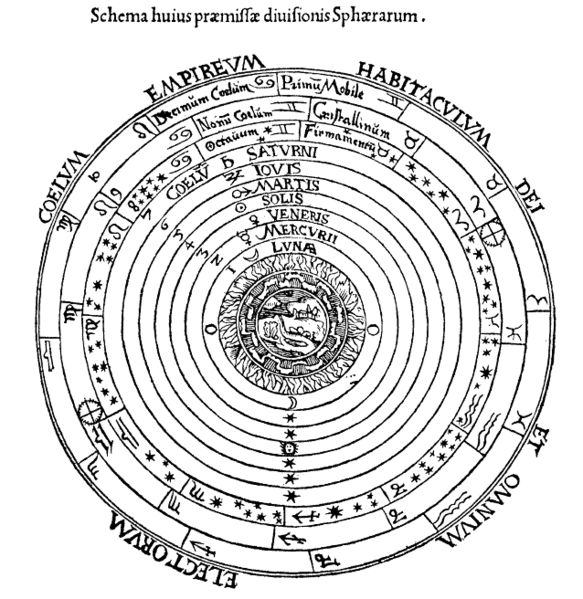
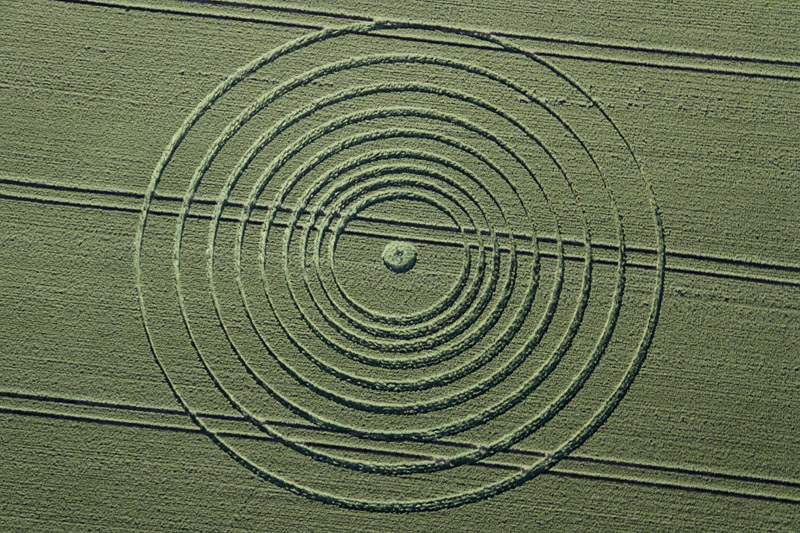
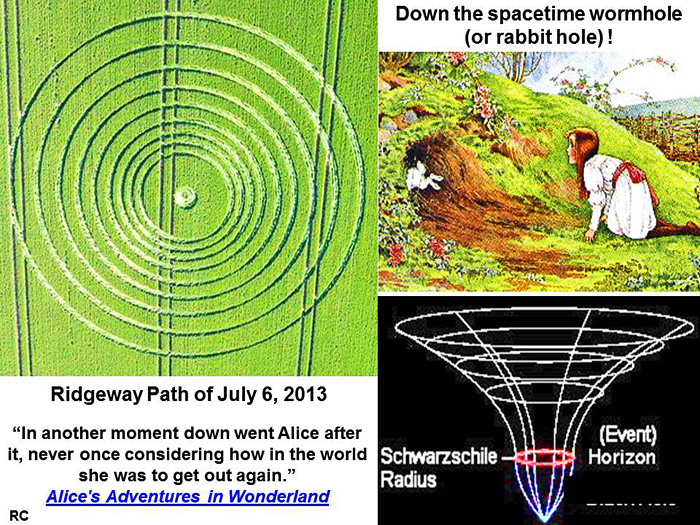
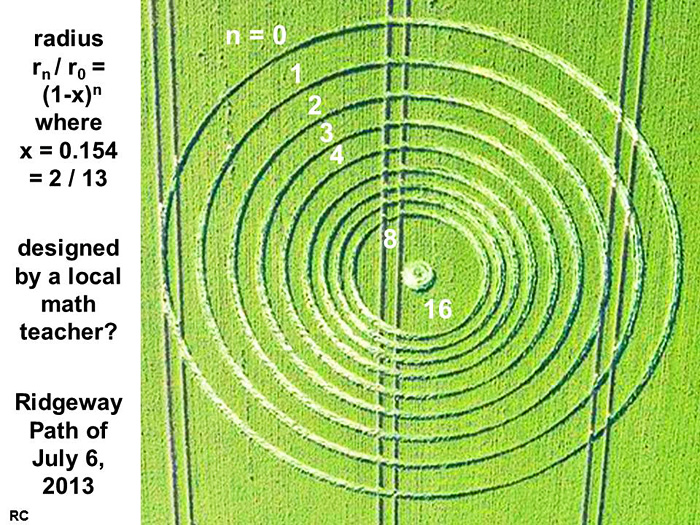

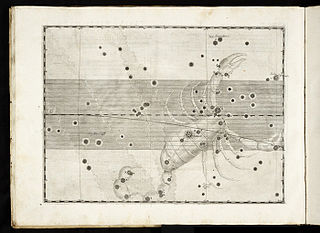
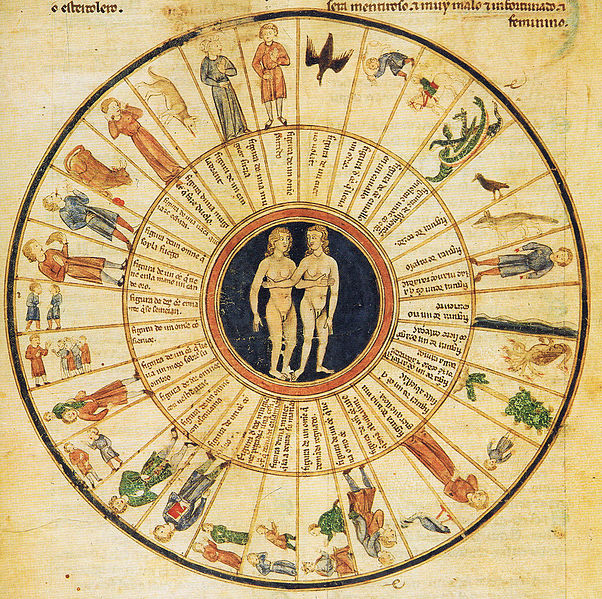


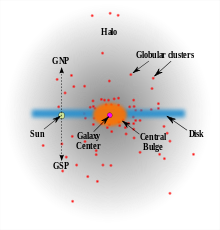

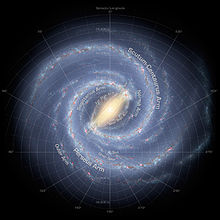
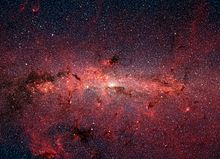
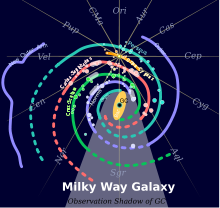
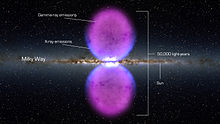

.png)
.png)
.png)

